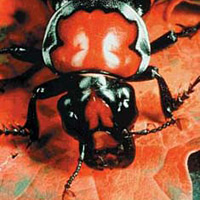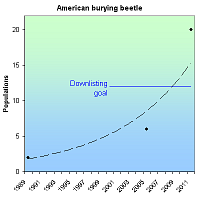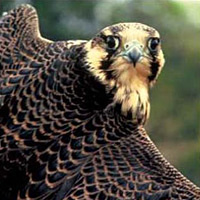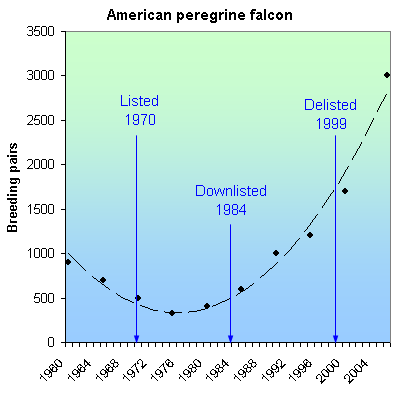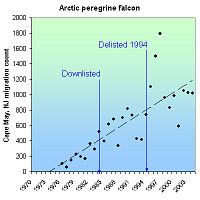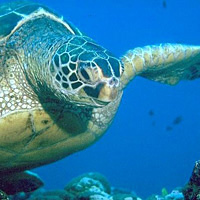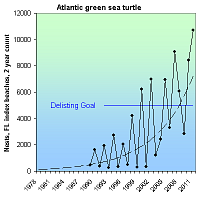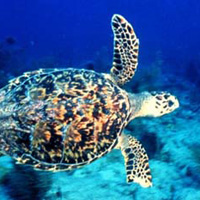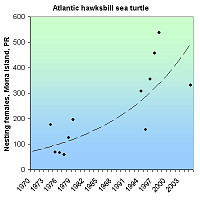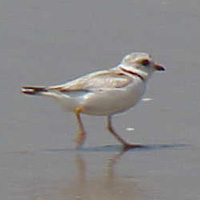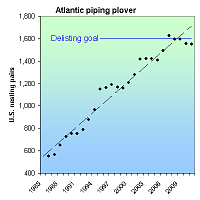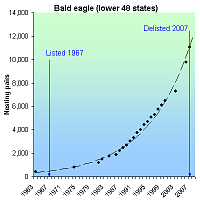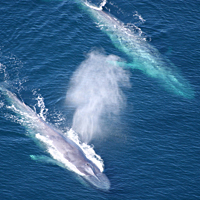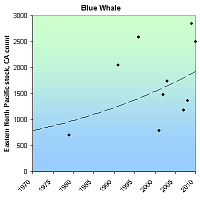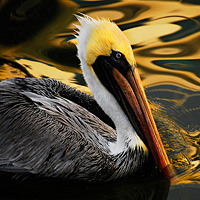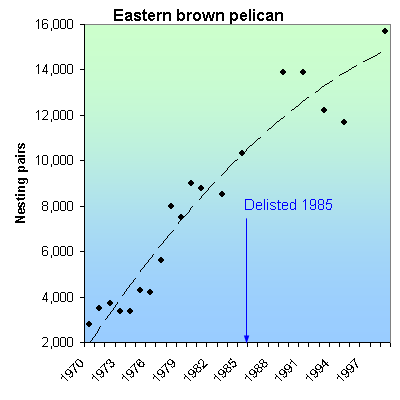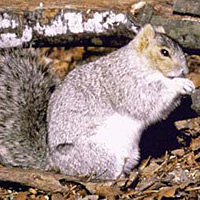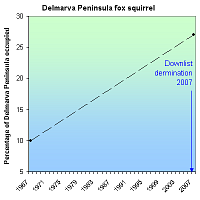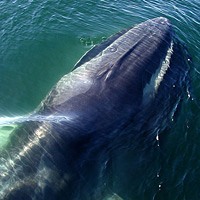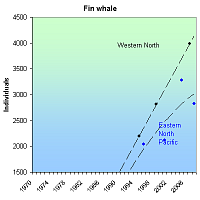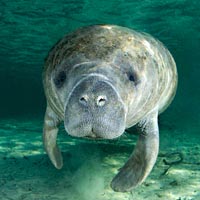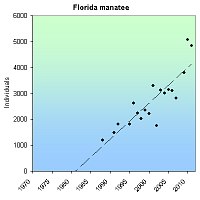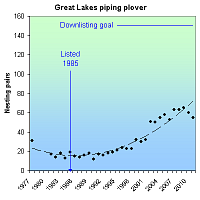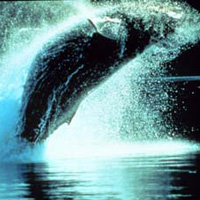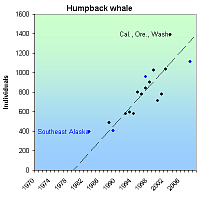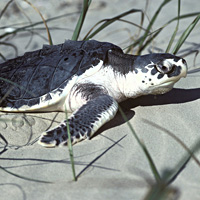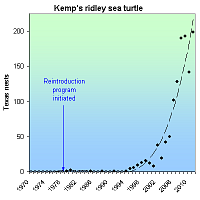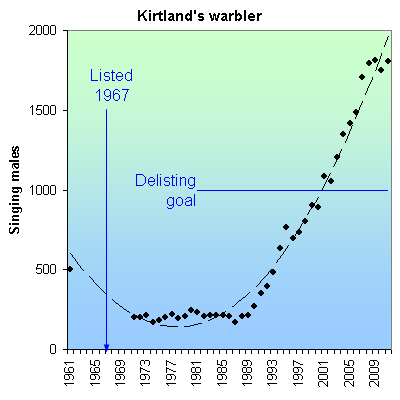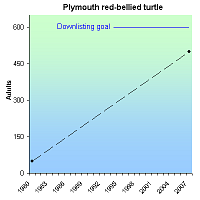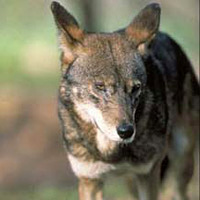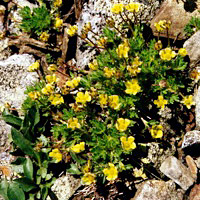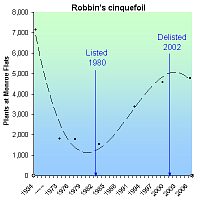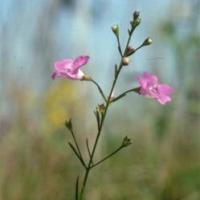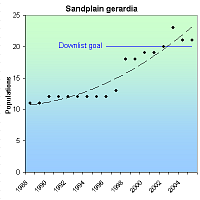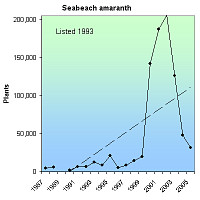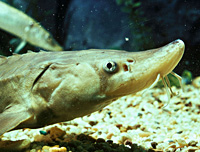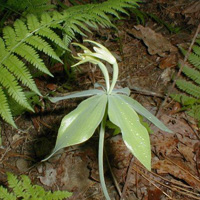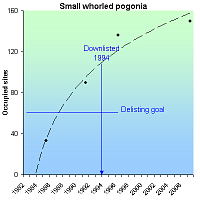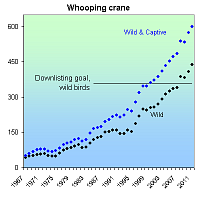American burying beetle (Nicrophorus americanus)
| Status: Endangered | Critical habitat: none |
| Listed: 8/13/1989 | Recovery plan: 9/27/1991 |
Range: AR(b), KS(b), MA(b), NE(b), OH(b), OK(b), RI(b), SD(b), TX(b) --- AL(x), CT(x), DE(x), DC(x), FL(x), GA(x), IL(x), IN(x), IA(x), KY(x), LA(x), ME(x), MD(x), MI(x), MN(x), MS(x), MO(x), MT(x), NH(x), NY(x), NJ(x), NC(x), ND(x), PA(x), SC(x), TN(x), VT(x), VA(x), WV(x), WI(x)
SUMMARY
The cause of the American burying beetle's 90% range loss is not well understood, but is thought to be due to disruptions in the food and reproductive web. It is threatened by competition, drought, invasive ants and habatat loss. When listed as endangered in 1989, there were only two known populations. Captive breeding, reintroduction efforts and intensive surveys have increased the total number of populations to 20 or more in 2011.
RECOVERY TREND
The American burying beetle (Nicrophorus americanus) is a large, spectacularly colored orange and black insect. It formerly occurred across a vast range from Nova Scotia south to Florida, west to Texas, and north to South Dakota. It was documented in 150 counties in 34 states, the District of Columbia, and three Canadian provinces. Total historical numbers are not known, but the species may well have occurred in the tens of millions. The burying beetle's dramatic decline has been called "difficult to imagine" and “one of the most disastrous declines of an insect’s range ever to be recorded” [2]. It was extirpated from mainland New England through New Jersey by the 1920s, from the entire mainland east of the Appalachian Mountains by the 1940s, and from the mainland east of the Mississippi River by 1974. It is absent from about 90 percent of its historic range.
The largest of North America's 32 burying beetles, N. americanus is uniquely dependent upon quail-size carrion weighing 100 to 200 grams [1, 15]. Males smell freshly dead mammals and birds (and occasionally even fish) within an hour of death and up to two miles away. Females arrive shortly thereafter, attracted by male pheromones. A competition ensues and is typically won by the largest male and female. Lying on their backs, the winning couple inches the carrion into an excavated burial chamber. During this time, orange phoretic mites borne by the beetles leap to the carcass, cleaning it of fly eggs and microbes. The buried carcass is relieved of its feathers, feet, tail, ears and/or fur. Now known as a "brood ball," it is coated with oral and anal embalming secretions to retard fungal and bacterial growth. The beetles then mate and within 24 hours lay eggs in the soil near the carcass. White grubs emerge three or four days later and are carried to the carcass. The parents also defend the grubs from predators and feed them regurgitated food. The American burying beetle is one of the few non-colonial insects in the world to practice dual parenting. In approximately a week, the grubs leave the chamber and pupate into adults.
The cause of the American burying beetle's decline is not well understood, but the most cogent hypotheses see it as victim of interacting food chain disturbances which reduced the number of large carcasses [2]. The passenger pigeon, which formerly occurred in the billions, was an ideal size. It was last seen in 1914 and was greatly reduced in number in the decades preceding. Its decline and disappearance occurred just prior to the burying beetle's. Other endangered or greatly reduced carrion of ideal size include the black-footed ferret, northern bobwhite, and greater prairie chicken. Competition for dwindling carrion numbers was exacerbated by increasing numbers of mid-sized predators following the extinction or decline of large predators such as the eastern cougar, mountain lion and gray wolf. In their absence, coyotes, raccoons, fox and other mid-size scavengers increased in number and consumed more quail-size carrion. Finally, as habitats became more fragmented mid-size predators were increasingly able to exploit forest and grassland edges, taking more carrion.
At the time of listing in 1989, two populations were known: one on Block Island, Rhode Island and one in eastern Oklahoma [1]. Since then, populations have been discovered in South Dakota (1995), Nebraska (1992), Kansas (1997), Arkansas (1992) and Texas (2003), as well as additional populations in Oklahoma [3, 23]. The total number of populations has increased to at least 20 as of 2011 [7, 11, 13, 10, 22, 23].
RHODE ISLAND. Located 12 miles off the south coast of Rhode Island, Block Island supports the last natural population of the American burying beetle east of the Mississippi River. The island is free of foxes, raccoons, skunks and coyotes. A study of one-third of the population determined that it was relatively stable between 1991 and 1997 (mean=184), steadily grew to 777 in 2006, and then declined to 80 in 2011 in part because of a reduction in supplementation of carcasses [8]. This population served as the source for the successful Roger Williams Park Zoo captive breeding program initiated in 1994 and for direct translocations to Nantucket and Penikese Island.
MASSACHUSETTS. The American burying beetle was extirpated from Massachusetts shortly after 1940 [1] and was reintroduced to the 70-acre Penikese Island in Buzzards Bay over a four-year period between 1990 and 1993. Reintroduced beetles initially came from a Boston University captive breeding population originating from Block Island stock [6]. The population persisted at low numbers through 2002, but was not located in 2003, 2004 or 2005. On Nantucket, 2,892 beetles were introduced from the Roger Williams Park Zoo between 1994 and 2005 to the Audubon Society’s Sesachacha Heathland Wildlife Sanctuary (east side of the island) and the Nantucket Conservation Foundation’s Sanford Farm (west side of the island) [5, 6, 21]. Existing and new beetles were trapped and provisioned with quail carcasses each summer to boost larva production [5]. The introduction program ended in 2005 in order to determine if population is self-sustaining [6]. The Penikese Island reintroduction effort has been deemed a failure, and the success of the Nantucket effort is unknown, although the population is believed to persist [23].
OHIO. The American burying beetle was extirpated from Ohio shortly after 1974 when it was last seen near Old Man's Cave in Hocking Hills State Park [9, 10]. A short-lived captive population derived from Block Island stock was established in 1991 at the Insectarium of the Cincinnati Zoo and Botanical Garden [1]. In July 1998, Ohio became the site of the first mainland introduction when 35 pairs of beetles taken from a wild population near Fort Chaffee, Ark. were introduced to the Waterloo Wildlife Experiment Station in southeast Ohio [10]. The Waterloo population was augmented in 1999 (20 pairs and 15 females) and 2000 (33 pairs and four males), but not 2001 or 2002. Additional augmentation occurred in 2003. A captive population established at Ohio State University in 2002 produced 828 beetles as of 2004; 199 of these were used for reintroductions in 2003 and 156 were reintroduced in 2004. The Wilds (managed by the Columbus Zoo) plans to create a second captive colony [10] and a second reintroduction is planned for the Athens District of the Wayne National Forest [11]. The success of the Ohio reintroduction efforts is unknown but is thought to be limited [23].
MISSOURI. The American burying beetle was extirpated from Missouri in the early 1980s [1]. It has not been relocated despite repeated and recent surveys [12]. A captive breeding population was established at the Monsanto Insectarium, St. Louis Zoo in 2004 (with 10 pairs from Ohio State University) and 2005 (with wild beetles from Arkansas) [7, 15]. Six-hundred-fifty-four adults were produced as of June 2005, 50 of which were transferred to Ohio State University. Plans are being developed to introduce the species to The Nature Conservancy and Missouri Department of Conservation lands. [7].
OKLAHOMA. The presence of American burying beetles has recently been confirmed in 22 eastern Oklahoma counties, reported but unconfirmed in two more, and likely to occur in nine more [16]. The largest known concentrations are a population at Camp Gruber and a smaller one on private timber lands held by Weyerhaeuser International. Captures (not to be confused with population estimates) at Camp Gruber fluctuated around a mean of 213 adults between 1992 and 2003 without discernable trend. Captures at Weyerhaeuser had a mean of 52 adults between 1997 and 2003, but this population collapsed in 2006 and 2007, perhaps due to drought or fire ants [23].
NEBRASKA. The American burying beetle was rediscovered in Nebraska in 1992 [18]. Between 1995 and 1997, nearly 1,000 individuals were trapped or collected in the upland grasslands and cedar tree savannas of the dissected loess hills south of the Platte River in Dawson, Gosper and Lincoln counties of Nebraska. The population is estimated at about 3,000 adults.
SOUTH DAKOTA. The American burying beetle was rediscovered in South Dakota in 1995 and is believed to have a statewide population in excess of 500 adults [17].
ARKANSAS. The American burying beetle was rediscovered in Arkansas in 1992 [3]
KANSAS. The American burying beetle was rediscovered in Kansas in 1997 [19].
TEXAS: The American burying beetle, thought to be extirpated from Texas since the 1930s, was rediscovered in 2003 [3]. Two populations are now known to exist, one on a military base, the other on a Nature Conservancy preserve.
The American burying beetle recovery plan states: "The interim objective [extinction avoidance] will be met when the extant eastern and western populations are sufficiently protected and maintained, and when at least two additional self-sustaining populations of 500 or more beetles are established, one in the eastern and one in the western part of the historical range. Reclassification will be considered when (a) 3 populations have been established (or discovered) within each of four geographical areas (Northeast, Southeast, Midwest, and the Great Lake states), (b) each population contains 500+ adults, (c) each population is self-sustaining for five consecutive years, and, ideally, each primary population contains several satellite populations.”
The beetle remains threatened by the limited availability of carcasses to use for reproduction, by invasive species such as fire ants which compete for carcasses, and by drought and climate change. The Keystone XL pipeline, which would transport tar sands oil from Canada to Texas, is a new threat to the beetle in 2011 and would cut through the core of the beetle's range in South Dakota, Nebraska and Oklahoma.
CITATION
[1] U.S. Fish and Wildlife Service. 1991. American burying beetle (Nicrophorus americanus) recovery plan. Newton Corner, MA.
[2] Sikes, D.S. 2002. A review of hypotheses of decline of the endangered American burying beetle (Silphidae: Nicrophorus americanus Olivier). Journal of Insect Conservation 6: 103–113
[3] Quinn, M. 2006. American Burying Beetle (ABB). Website (http://www.texasento.net/ABB.htm) accessed January 29, 2006.
[4] Peyton, M.M. 1997. Notes on the range and population size of the American Burying beetle (Nicrophorus americanus) in the dissected hills south of the Platte River in central Nebraska. Paper presented at the 1997 Platte River Basin Ecosystem Symposium, Feb. 18-19, 1997 Kearney Holiday Inn Kearney, Nebraska.
[5] Mckenna-Foster, A.A., M.L. Prospero, L. Perrotti, M. Amaral, W.T. Maple, and R.S. Kennedy. 2005. American burying beetle (Nicrophorus americanus) survey and reintroduction to Nantucket, MA, 2004-2005. Abstract presented at the First Nantucket Biodiversity Initiative Conference, September 24, 2005, Coffin School, Egan Institute of Marine Studies, Nantucket, MA.
[6] Amaral, M. 2005. Personal communication with Michael Amaral, U.S. Fish and Wildlife Service, Concord, NH, November 28, 2005.
[7] Homer, P. 2005. Missouri's Threatened and Endangered Species Accomplishment Report: July 1, 2004 - June 30, 2005. Missouri Department of Conservation.
[8] Raithel, C. 2012. American burying beetle, Southwest Block Island trend, 1991-2011. Spreadsheet provided by Christopher Raithel, Rhode Island Dept of Environmental Management, Rhode Island Division of Fish and Wildlife, April 5, 2012.
[9] Ohio Department of Natural Resources, Division of Wildlife. 2005. American Burying Beetle, Nicrophorus americanus. Website (www.dnr.state.oh.us/wildlife/Resources/projects/beetle/beetle.htm) accessed January 28, 2006.
[10] Ohio Department of Natural Resources, Division of Wildlife. 2004-2005 Wildlife Population Status and Hunting Forecast.
[11] Wayne National Forest. 2004. Schedule of Proposed Action, 10-01/04-12/31/04.
[12] Stevens, J. and B. Merz. American Burying Beetle Survey in Missouri. St. Louis Zoo, Department of Invertebrate. Website (http://biology4.wustl.edu/tyson/projectszoo.html) accessed January 29, 2006.
[13] Dabeck, L. 2006. The American Burying Beetle Recovery Program: Saving nature's most efficient and fascinating recyclers. Roger Williams Park Zoo. Website (www.rogerwilliamsparkzoo.org/conservation/burying%20beetle%20program.cfm) accessed January 29, 2006.
[14] Kozol, A. J. 1990. NICROPHORUS AMERICANUS 1989 laboratory population at Boston University: a report prepared for the U.S. Fish and Wildlife Service. Unpublished report.
[15] Stevens, J. 2005. Conservation of the American burying beetle. CommuniQue, September, 2005:9-10.
[16] U.S. Fish and Wildlife Service. 2006. American Burying Beetle (Nicrophorus americanus). U.S. Fish and Wildlife Service. Website (www.fws.gov/ifw2es/Oklahoma/beetle1.htm) accessed January 29, 2006.
[17] South Dakota Game, Fish and Parks. 2006. The American Burying Beetle in South Dakota. Website (www.sdgfp.info/Wildlife/Diversity/ABB/abb.htm) accessed January 29, 2006.
[18] Peyton, M.M. 2003. Range and population size of the American burying beetle (Coleoptera:Silphidae) in the Dissected Hills of South-central Nebraska. Great Plains Research 13(1): 127-138
[19] Miller, E.J. and L. McDonald. 1997. Rediscovery of Nicrophorus americanus Olivier (Coleoptera Silphidae) in Kansas. The Coleopterists' Bulletin 5(1):22.
[20] Mckenna-Foster, A., W.T. Maple, and R.S. Kennedy. 2005. American Burying Beetle (Nicrophorus americanus) survey and reintroduction on Nantucket 2005. Unpublished report.
[21] Perrotti, L. 2006. Roger Williams Park Zoo American Burying Beetle Project Statistics. Spreadsheet provided by Lou Perrotti, American Burying Beetle project coordinator, Roger Williams Park Zoo, Providence, RI, February, 2006.
[22] NatureServe. 2011. American Burying Beetle Species Profile. Available at: http://www.natureserve.org
[23] U.S. Fish and Wildlife Service. 2008. American Burying Beetle (Nicropherus americanus) 5-Year Review Summary and Evaluation. 53 pp.
American peregrine falcon (Falco peregrinus anatum)
| Status: Delisted | Critical habitat: 8/11/1977 |
| Listed: 6/2/1970 | Recovery plan: 6/30/1991 |
Range: AL(m), AK(b), AZ(b), AR(m), CA(b), CO(b), CT(b), DE(b), DC(m), GA(b), ID(b), IL(b), IN(b), IA(b), KS(m), KY(b), LA(m), ME(b), MD(b), MA(b), MI(b), MN(b), MS(m), MO(m), MT(b), NE(b), NV(b), NH(b), NY(b), NM(b), NJ(b), NC(b), ND(m), OH(b), OK(m), OR(b), PA(b), RI(b), SC(b), SD(b), TN(b), TX(b), UT(b), VT(b), VA(b), WA(b), WV(m), WI(b), WY(b) ---
SUMMARY
The use of DDT and other organochlorine pesticides thinned American peregrine falcon eggshells, causing reproductive failure and population declines. The banning of DDT, captive-breeding efforts and nest protections allowed falcons to increase from 324 breeding pairs in 1975 to 3,005 pairs as of 2006. The species was delisted in 1999.
RECOVERY TREND
The American peregrine falcon (Falco peregrinus anatum) breeds only in North and Central America and occurs throughout much of North America from the subarctic boreal forests of Alaska and Canada south to Mexico [1]. It is estimated that prior to the 1940s, there were approximately 3,875 nesting pairs of peregrines in North America [1]. From the 1940s through the 1960s, however, the population of the peregrine, and many other raptors, crashed as a result of the introduction of synthetic organochlorine pesticides to the environment. By 1975, there were only 324 known nesting pairs of American peregrine falcons in the U.S. [2].
Scientists investigating the peregrine's decline found unusually high concentrations of the pesticide DDT and its breakdown product DDE in peregrine falcons and other birds of prey [1]. Organochlorine pesticides were put into use following World War II. Use peaked in the late 1950s and early 1960s and continued through the early 1970s [1]. Organochlorine pesticides cause direct mortality and reduced reproduction in birds of prey because they ingest high doses of pesticides concentrated and stored in the fatty tissue of prey animals that themselves ingested contaminated food [1]. Heavily contaminated females may fail to lay eggs and organochlorines passed from the female to the egg can kill the embryo before it hatches [1]. DDE, the principal metabolite of DDT, prevents normal calcium deposition during eggshell formation, causing eggs to frequently break before hatching [1]. During the period of DDT use in North America, eggshell thinning and nesting failures were widespread in peregrine falcons, and in some areas, successful reproduction virtually ceased [1].
The degree of exposure to these pesticides varied among regions, and peregrine falcon numbers in more contaminated areas suffered greater declines [1]. The eastern population plunged from an estimated 350 active nest sites in the 1930s and 1940s to no active breeding birds from 1964 to 1975 [3]. Peregrine falcons in the Great Plains states east of the Rocky Mountains and south of U.S. and Canadian boreal forests were also essentially extirpated [1]. West of the 100th meridian, peregrine falcons were significantly reduced [1]. Local populations were greatly depressed or extirpated and by 1965 fewer than 20 pairs were known west of the U.S. Great Plains [1].
In 1970, the American peregrine was listed as endangered and efforts to recover the species began. The use of DDT was banned in Canada in 1970 and in the United States in 1972 [1]. This was the single-most significant action in the recovery of the peregrine falcon [1]. In addition, in the eastern United States, efforts were made to reestablish peregrine falcons by releasing offspring from a variety of wild stocks that were held in captivity by falconers [1]. The first experimental releases of captive-produced young occurred in 1974 and 1975 in the eastern United States [1]. These and future releases demonstrated that “hacking,” the practice of retaining and feeding young captive bred birds in partial captivity until they are able to fend for themselves, was an effective method of introducing captive-bred peregrines to the wild [1]. Since then, more than 6,000 falcons have been released in North America [1]. Approximately 3,400 peregrines were released in parts of southwest Canada, the northern Rocky Mountain States, and the Pacific Coast states [1].
In the late 1970s, Alaska became the first place American peregrine falcon population growth was documented and, by 1980, populations began to grow in other areas [1]. Not only did the number of peregrine falcons begin to increase, productivity (another important measure of population health) improved [1]. Efforts to reestablish peregrine falcons in the East and Midwest proved largely successful, leading to downlisting of the species in 1984 [1], and by 1999 peregrines were found to be nesting in all states within their historical range east of the 100th meridian, except for Rhode Island, West Virginia and Arkansas [1]. In highly urban areas, peregrine falcons showed great adaptability, and began substituting skyscrapers for natural cliff faces as nesting sites [4]. By 1998, the total known breeding population of peregrine falcons was 1,650 pairs in the United States and Canada, far exceeding the recovery goal of 456 pairs. Other recovery goals, including estimates of productivity, egg-shell thickness, and contaminants levels, had also been met, allowing the species to be delisted in 1999 [1]. Monitoring of American peregrine populations has continued under a post-delisitng monitoring plan [5]. The estimated North American population was 3,005 pairs as of 2006 [6].
ALASKA: Surveys conducted between 1966 and 1998 along the upper Yukon River demonstrated increases in the number of occupied nesting territories from a low of 11 known pairs in 1973 to 46 pairs in 1998 [1]. Similarly, along the upper Tanana River, the number of occupied nesting territories increased from two in 1975 to 33 in 1998 [1]. The recovery objective of 28 occupied nesting territories in the two study areas was first achieved in 1988, with 23 nesting territories on the Yukon River and 12 on the Tanana River [1].
PACIFIC STATES: By 1976, no American peregrine falcons were found at 14 historical nest sites in Washington [1]. Oregon had also lost most of its peregrine falcons and only one or two pairs remained on the California coast [1]. Surveys conducted from 1991 to 1998 indicated a steadily increasing number of American peregrine falcon pairs breeding in Washington, Oregon and Nevada [1]. Known pairs in Washington increased from 17 to 45 and in Oregon from 23 to 51 [1]. The number of American peregrine falcons in California increased from an estimated low of five to 10 breeding pairs in the early 1970s to a minimum of 167 occupied sites in 1998 [1]. The increase in California was concurrent with the restriction of DDT and included the release of more than 750 American peregrine falcons through 1997 [1].
ROCKY MOUNTAINS/SOUTHWEST: The Rocky Mountain/Southwest population of the American peregrine falcon has made a profound comeback since the late 1970s when surveys showed no occupied nest sites in Idaho, Montana or Wyoming and only a few pairs in Colorado, New Mexico and the Colorado Plateau, including parts of southern Utah and Arizona [1]. Surveys conducted from 1991 through 1998 indicated that the number of American peregrine falcon pairs in the Rocky Mountain/Southwest area has steadily increased [1]. In 1991, there were 367 known pairs; in 1998 the number of pairs increased to 535 [1].
EASTERN STATES: The eastern peregrine population has a unique history and complex status under the Act [1]. Peregrine falcons were extirpated in the eastern United States and southeastern Canada by the mid-1960s [1]. Releases of young captive bred peregrines have reestablished populations throughout much of their former range in the East [1]. In 1998, 193 pairs were counted in five designated eastern state recovery units [1]. The number of territorial pairs recorded in the eastern peregrine falcon recovery area increased an average of 10 percent annually between 1992 and 1998 [1]. Equally important, the productivity of these pairs during the same seven-year period averaged 1.5 young per pair, demonstrating sustained successful nesting [1].
CITATIONS
[1] U.S. Fish and Wildlife Service. 1999. Final Rule to Remove the American Peregrine Falcon from the Federal List of Endangered and Threatened Wildlife, and to Remove the Similarity of Appearance Provision for Free-Flying Peregrines in the Conterminous United States. Federal Register (64 FR 46542).
[2] Hoffman, C. 1999. The Peregrine Falcon is Back! New release, U.S. Fish and Wildlife Service, August 20, 1999.
[3] Clark, K. 2005. The Peregrine Falcon in New Jersey, Report for 2005. New Jersey Department of Environmental Protection, Division of Fish and Wildlife, Endangered and Nongame Species Program.
[4] New Jersey Division of Fish and Wildlife. Fact sheet, Peregrine Falcon Falco pereginus. New Jersey Department of Environmental Protection, Division of Fish and Wildlife, Endangered and Nongame Species Program. Website <http://www.njfishandwildlife.com/tandespp.htm> accessed February, 2006.
[5] U.S. Fish and Wildlife Service. 2003. Monitoring Plan for the American Peregrine Falcon, A Species Recovered Under the Endangered Species Act. U.S. Fish and Wildlife Service Division of Endangered Species and Migratory Birds and State Programs. Pacific Region, Portland Oregon 53pp.
[6] Green, M., T. Swem, M. Morin, R. Mesta, M. Klee, K. Hollar, R. Hazelwood, P. Delphey, R. Currie, and M. Aramal. 2006. Monitoring Results for Breeding American Peregrine Falcons (Falco peregrinus anatum), 2003. Biological Technical Publication BTP-R1005-2006. U.S. Department of Interior, Washington, D.C.
Arctic peregrine falcon (Falco peregrinus tundrius)
| Status: Delisted | Critical habitat: none | Listed: 6/2/1970 | Recovery plan: 6/30/1991 |
Range: AL(m), AK(b), AZ(m), AR(m), CA(m), CO(m), CT(m), DE(m), DC(m), FL(m), GA(m), ID(m), IL(m), IN(m), IA(m), KS(m), KY(m), LA(m), ME(m), MD(m), MA(m), MI(m), MN(m), MS(m), MO(m), MT(m), NE(m), NV(m), NH(m), NY(m), NM(m), NJ(m), NC(m), ND(m), OH(m), OK(m), OR(m), PA(m), RI(m), SC(m), SD(m), TN(m), TX(m), UT(m), VT(m), VA(m), WA(m), WV(m), WI(m), WY(m) ---
SUMMARY
The Arctic peregrine falcon declined due to the egg shell-thinning effects of DDT and other organochlorine pesticides. Its listing as an endangered species in 1970 (along with other birds of prey) prompted the EPA to ban DDT in 1972. Counts of migratory Arctic falcons increased from 103 in 1976, to 1,017 in 2004. The species was downlisted to threatened in 1984 and delisted in 1991.
RECOVERY TREND
The Arctic peregrine falcon (Falco peregrinus tundrius) is one of three peregrine falcon subspecies [1]. It nests in tundra regions of Alaska, Canada (Yukon, Northwest Territories, Quebec, and possibly Labrador), and the ice-free perimeter of Greenland [1]. It is a long-distance migrant that winters in Latin America from Cuba and Mexico south through Central and South America [1].
Severe declines in peregrine falcon numbers began in the 1950s [1]. These declines were linked to organochlorine pesticides that were put into use following World War II, and whose use peaked in the late 1950s-early 1960s [1]. Scientists investigating the peregrine's decline found unusually high concentrations of the pesticide DDT and its breakdown product DDE in peregrine falcons and other birds of prey [2]. Organochlorine pesticides cause direct mortality and reduced reproduction in birds of prey which, being at the top of the food chain, ingest high doses of pesticides concentrated and stored in the fatty tissue of prey animals that themselves ingested contaminated food [1]. Heavily contaminated females may fail to lay eggs and organochlorines passed from the female to the egg can kill the embryo before it hatches. DDE, the principal metabolite of DDT, prevents normal calcium deposition during eggshell formation, causing eggs to frequently break before hatching [1]. Arctic peregrine numbers reached their lowest levels in the early 1970s and in some areas of North America successful reproduction virtually ceased [1]. Populations are thought to have decreased by as much as 80 percent [2].
The listing of the Arctic peregrine falcon as endangered in 1970--as well as the bald eagle, brown pelican, and American peregrine falcon shortly before--fostered a national outcry against the production and spaying of DDT. In 1972, the Environmental Protection Agency banned most used of DDT in the United States [1]. Canada had already restricted DDT use in 1970. These restrictions are the central cause of the recovery of the Arctic and American peregrine falcons (the bald eagle and brown pelican benefited greatly as well, but their recovery also involved substantial habitat protections and reintroductions).
As DDT levels declined after 1972, peregrine falcon productivity rates rose to pre-DDT levels and the population size and range began to increase. This happened most rapidly in northern areas, where pesticide exposur was lower and impacts upon populations were less severe [1]. In 1984, the U.S. Fish and Wildlife Service downlisted the Arctic peregrine falcon from endangered to threatened status [2, 6]. In 1991, the agency initiated a review determine if the species had recovered [2] and in 1994 removed it from the endangered species list [6].
Four major factors were considered in the delisting process: (1) Population size and trend, (2) reproductive performance, (3) pesticide residues in eggs, and (4) eggshell thickness [1]. Despite a lack of long-term studies using consistent methodologies, there was strong evidence of significant population increases throughout the Arctic [1]. Four areas in northern North America (one in Alaska and three in Canada’s North West Territories) for which historical survey information was available indicated the number of Arctic peregrine pairs occupying nesting territories increased since the 1960s [1]. Some areas of Alaska even exceeded the original estimates of pre-DDT-era population size [1]. In addition, in the eastern Arctic, peregrines began nesting in previously vacant nesting sites [1]. Standardized yearly migration counts at New Jersey’s Cape May, an area where Arctic peregrines concentrate during migration, also saw increasing numbers, most likely from Arctic breeding grounds especially in Greenland and eastern Canada (these counts may have also contained peregrines in the American subspecies; however, banding recoveries indicate that the majority of peregrines along the East Coast during fall migration are from the Arctic and thus represent a true increase in Arctic peregrine numbers) [1].
Productivity in all regions where data had been gathered was sufficient to support a stable or increasing population since the 1980s [1]. There had also been improvements in levels of DDE concentration in eggs. Concentrations in excess of 15-20 parts per million (wet weight basis) are associated with high rates of nesting failure. Residue in eggs in 1993 was well below this critical level [1]. Alaskan eggshells collected between 1988 to 1991 were on average only 12 percent thinner than pre-DDT thickness (17 percent or greater reduction in thickness results in population declines).
Arctic peregrine falcon numbers have continued to rise after the species' delisting. On the Sagavanirktok River in Alaska, where Arctic peregrine surveys have been conducted since the late 1950s, the number of pairs increased from five in 1958, to 23 in 1992, to 25 in 1999 [3]. Migration counts at the Cape May Hawkwatch site in New Jersey increased from 103 in 1976 to 1,024 in 2003 [4].
CITATIONS
[1] U.S. Fish and Wildlife Service. 1993. Proposal to Remove the Arctic Peregrine Falcon From the List of Endangered and Threatened Wildlife. 58 Fed. Reg 188.
[2] U.S. Fish and Wildlife Service. 1995. Peregrine falcon, (Falco peregrinus anatum, Falco peregrinus tundrius, Falco peregrinus pealei). Species account. Website <http://www.fws.gov/species/species_accounts/bio_pere.html> accessed October, 2005.
[3] Wright, J.M. and P.J. Bente. 1999. Documentation of active peregrine falcon nest sites, 1 Oct 1994- 31 March 1998. Alaska Department of Fish and Game. Annual research report. Endangered species conservation fund federal aid project SE-2-9, 10, and 11. Juneau, AK. 15 pp.
[4] Cape May Bird Observatory. 2012. Cape May Hawkwatch, Cape May, New Jersey. New Jersey Audubon Society. Website <http://www.njaudubon.org/Sightings/cmhw25.html> accessed April 2, 2012.
[5] NatureServe. 2011. NatureServe’s Central Databases. Arlington, VA. U.S.A
[6] U.S. Fish and Wildlife Service. 1994. Removal of Arctic Peregrine Falcon From the List of Endangered and Threatened Wildlife. 59 Fed. Reg. 50796.
Atlantic green sea turtle (Chelonia mydas mydas)
| Status: Threatened/Endangered | Critical habitat: 9/2/1998 | Listed: 7/28/1978 | Recovery plan: 5/18/1999 |
Range: AL(s), CT(s), DE(m), FL(b), GA(b), LA(s), MA(s), MS(s), NY(s), NJ(s), NC(b), PR(b), RI(s), SC(b), TX(s), VI(b), VA(m) ---
SUMMARY
The Atlantic green sea is threatened by egg collection, hunting, vandalism, disturbance while nesting, beach development, habitat loss, and sea level rise. Its population has increased in the United States since being listed as endangered in 1978, but systematic surveys only began in 1989. It grew by 2,206% in Florida between 1989 and 2011 (464 to 10,701) and has achieved its population size recovery goal.
RECOVERY TREND
The green sea turtle (Chelonia mydas) occurs throughout the tropical and subtropical waters of the Mediterranean, Atlantic, Pacific and Indian oceans, and as far north as Massachusetts [1, 2]. It migrates enormous distances between foraging and nesting areas [2]. When not migrating, the green sea turtle’s typical near-shore habitat includes shallow waters inside bays, reefs and inlets [1]. Most nesting occurs on minimally disturbed open beaches [3]. Females generally breed every two or more years, and nest an average of three to four times per breeding year [4].
Exploitation of the green sea turtle, its eggs and its habitat resulted in population declines [1]. Although green sea turtle populations continue to decline throughout much of their range due to directed harvest (both illegal and legal), incidental capture in near-shore gillnets, and negative impacts on essential habitats [1], two populations that nest in the United States (Florida and Hawaii) have increased in size since the species was placed on the endangered list in 1978 [3].
Green sea turtle populations in the U.S. Atlantic occur from Massachusetts to Texas and the Caribbean [1, 2]. In the U.S. Pacific, green sea turtles occur from the mainland coast to Hawaii, Guam and the Mariana Islands [1, 2]. Atlantic green sea turtles are variously considered a population and a subspecies (Chelonia mydas mydas) [1]. In the U.S. Atlantic, nesting occurs primarily on beaches along Florida’s east coast, although smaller numbers of nests can be found in North Carolina, South Carolina, Georgia, the U.S. Virgin Islands and Puerto Rico [5]. Foraging occurs in the Gulf of Mexico to Texas and along the Atlantic Coast to Massachusetts [1].
CARIBBEAN
Reliable, long-term nesting data are unavailable for Puerto Rico and the Virgin Islands [8]. The number of green turtle nests has remained low for all the islands, but there appears to have been a gradual increase in the numbers of juveniles observed in foraging grounds since the mid-1970s [8]. The largest concentration of nests occurs on St. Croix, where an average of 100 were counted per year between 1980 and 1990. Waters surrounding the island of Culebra, Puerto Rico have been designated critical habitat [1].
FLORIDA
State-wide population counts have been conducted in Florida since the 1970s, but are not strictly controlled for survey effort and area, especially in the early years. Thus while it is known that Florida's nesting green sea turtle population has increased since the 1970s, it is not possible to determine by how much. Standardized surveys on a large number of "index beaches" was initiated in 1989. They demonstrate that the number of annual green sea turtle nests increased by 2,206% between 1989 and 2011 (464 to 10,701) [4].
The number of green sea turtle nests in Florida (and in many other places), generally alternates between high and low years. Between 1989 and 2001, the number of nests in low years remained flat (250-500). Between 2003 and 2011 it grew sharply. Nesting in high years grew throughout 1989-2011, but more sharply starting in 1998.
An unusually low count in 2004 was caused by a hurricane. The biennial cycle was broken in 2009 and 2011, resulting in the highest recorded count in what should have been a low year (2011 = 10,701). It is possible to predict at this point if 2012 will be a high or low year.
NORTHERN STATES
Each winter green, Kemps Ridley and loggerhead sea turtles migrating southward from northeastern waters are regularly stranded on shores of Cape Cod Bay between Brewster and Truro [7]. These turtles die of hypothermia if not rescued. The total number of strandings ranged between 49 and 281 turtles between 1995 and 2003. Green sea turtle strandings ranged from zero to seven each year [7]. A volunteer program has been established to rescue, rehabilitate and release the turtles in Florida.
In 2005, the first verified green sea turtle nest was found in Virginia. A few females previously had laid eggs on beaches as far north as North Carolina's Outer Banks [10].
RECOVERY PLAN
In order for the green sea turtle to be delisted, the 1991 federal recovery plan requires that Florida supports an average of 5,000 nests over six consecutive years [1]. This criterion was met in 2009, 2010, and 2011 on the index beaches. As these are a subset of all nesting beaches, the delisting criteria was met in at least all years between 2007 and 2011.
The recovery plan also requires that 2) at least 105 kilometers of nesting beach be in public ownership and support at least 50 percent of U.S. nests, and 3) a reduction in stage-class mortality results in an increase in individuals in foraging grounds [1].
CITATIONS
[1] U.S. Fish and Wildlife Service. 1991. Recovery Plan for U.S. Populations of Atlantic Green Turtle. Washington, DC.
[2] Plotkin, P.T. (editor). 1995. National Marine Fisheries Service and U. S. Fish and Wildlife Service Status Reviews for Sea Turtles Listed under the Endangered Species Act of 1973. Silver Spring, Maryland.
[3] U.S. Fish and Wildlife Service. 2004. Green Sea Turtle (Chelonia mydas). U.S. Fish and Wildlife Service, North Florida Office. Website (http://www.fws.gov/northflorida/SeaTurtles/Turtle%20Factsheets/Green-Sea-Turtle.htm) accessed January, 2006.
[4] Florida Fish and Wildlife Conservation Commission. 2012. Index Nesting Beach Survey Totals (1989-2011). Available at (http://myfwc.com/research/wildlife/sea-turtles/nesting/beach-survey-totals/, accessed May, 2012).
[5] National Marine Fisheries Service. Green Sea Turtle (Chelonia mydas). Threatened Species Account. Endangered Florida and Mexican Breeding Populations. NOAA Fisheries, Office of Protected Resources. Silver Spring, MD. Website (http://www.nmfs.noaa.gov/pr/species/turtles/green.html) accessed January, 2006.
[6] Fish and Wildlife Research Institute. 2006. Florida's index nesting beach survey data. Fish and Wildlife Research Institute, Florida Fish and Wildlife Conservation Commission,. Website (http://research.myfwc.com/features/view_article.asp?id=10690) accessed January, 2006.
[7] Lewis, D. Photo diary of a terrapin researcher. Website (http://terrapindiary.org/) accessed January 7, 2006.
[8] Hillis-Starr, Z.M., R. Boulon, M. Evans. Sea turtles in the Virgin Islands in Status and trends of the Nation's Biological Resources, USGS. Available at (http://biology.usgs.gov/s+t/SNT/noframe/cr136.htm, accessed January, 2006.)
[9] Orlando Sentinel. August 6, 2005. Green Sea Turtle makes odd egg-laying visit to Virginia. Page A20.
Atlantic hawksbill sea turtle (Eretmochelys imbricata imbricata)
| Status: Endangered | Critical habitat: 9/2/1998 | Listed: 6/2/1970 | Recovery plan: 5/18/1999 |
Range: AL(s), CT(o), DE(o), FL(b), GA(o), LA(s), MD(o), MA(o), MS(s), NY(o), NJ(o), NC(o), PR(b), RI(o), SC(o), TX(s), VI(b), VA(o) ---
SUMMARY
Globally, the number of hawksbill sea turtles may have declined by as much as 80 percent over the past century due to commerce in their shells, poaching, habitat loss, bycatch and entanglement in marine debris. Although hawksbill numbers continue to decline globally, at protected beaches on Mona Island, Puerto Rico, nests increased from 177 in 1974 to 332 in 2005.
RECOVERY TREND
Hawksbill sea turtles (Eretmochelys imbricatause) use different habitats at different stages of their life cycle [1]. Post-hatchling hawksbills occupy pelagic environments, taking shelter in weedlines that accumulate at convergence zones [1]. They reenter coastal waters when they reach approximately 20 to 25 centimeters carapace length [1]. Coral reefs are used as resident foraging habitat by juveniles, subadults and adults [1]. Along the eastern shores of continents where coral reefs are absent, hawksbills are known to inhabit mangrove-fringed bays and estuaries [1]. They feed primarily on sponges [1, 2]. Female hawksbills nest on low- and high-energy beaches of tropical oceans. Throughout their range, hawksbills typically nest at low densities with aggregations consisting of a few dozen, or at most a few hundred individuals [1]. Nests have been found on both insular and mainland beaches where nests are typically placed under vegetation [1]. Migratory patterns of hawksbills are not well known, although a reproductive migration is thought to take place [1, 2].
Hawksbills occur in tropical and subtropical seas of the Atlantic, Pacific and Indian oceans and nest on beaches in at least 60 different nations [3]. Along the eastern and Gulf coasts of the continental U.S., hawksbills have been reported by all of the Gulf states and from as far north as Massachusetts, although sightings north of Florida are rare [1]. Representatives of at least some life-history stages regularly occur in southern Florida (where the warm Gulf Stream current passes close to shore) and the northern Gulf of Mexico (especially Texas), in the Greater and Lesser Antilles, and along the Central American mainland south to Brazil [1].
The largest remaining concentrations of nesting hawksbills occur on the beaches of remote oceanic islands of Australia and the Indian Ocean [1]. The Yucatan Peninsula in Mexico also supports a significant population of nesting hawksbills [1]. Within U.S. jurisdiction, nesting occurs principally on beaches in Puerto Rico and the U.S. Virgin Islands [1]. The most important nesting sites are Mona Island (Puerto Rico) and Buck Island (St. Croix, U.S. Virgin Islands) [1]. Within the continental United States, nesting is restricted to the southeastern coast of Florida and the Florida Keys, where one or two nests have been reported annually [1].
Quantitative data on population changes of hawksbills are scarce, in part because hawksbills were already greatly reduced in number when scientific studies of sea turtles began in the late 1950s [3]. In addition, visual evidence of hawksbill nesting is the least obvious among the sea turtle species, because hawksbills often select remote pocket beaches with little exposed sand to leave traces of revealing crawl marks [1]. An estimate of the minimum number of female hawksbills in 1989 indicated that at least 15,000 to 25,000 female hawksbills nested annually worldwide [4]. Although global numbers are very difficult to estimate, it appears that this turtle has suffered drastic decline, probably by as much as 80 percent over the last century (3). Only five regional populations, Seychelles, Mexico, Indonesia, and two in Australia, support more than 1,000 nesting females annually [3]. Hawksbill populations are either known or suspected to be declining in 38 of the 65 geopolitical units for which nesting density estimates are available [3].
CARIBBEAN
Hawksbill populations in the Western Atlantic-Caribbean region are thought to be greatly depleted [3]. In the Caribbean region, the number of females nesting annually is about 5,000 (order-of-magnitude estimate) [3]. With few exceptions, all of the countries in the Caribbean report fewer than 100 females nesting annually [3]. The largest known nesting concentrations are in the Yucatan Peninsula of Mexico [3]. These populations may be increasing [3]. A total of 4,522 nests were recorded in the states of Campeche, Yucatán and Quintana Roo in 1996, compared to only a few hundred in the early 1980s [5].
In the U.S Caribbean, there is evidence that hawksbill nesting populations have been severely reduced during the 20th century [1]. Estimates of the size of nesting populations under U.S. jurisdiction are available for only a few localities [1]. Although trends are uncertain due to long intervals between hawksbill nesting generations (hawksbill take between 30 and 40 years to reach sexual maturity) and fluctuations in the number of reproductive females that nest in a particular year [3], hawksbill numbers increased at two protected locations, Mona Island, Puerto Rico and at Buck Island Reef National Monument, U.S. Virgin Islands [5]. The number of nests on Mona Island increased from 177 in 1974 to 332 in 2005 [5, 6]. On Buck Island, the number of nesting females increased from 73 in 1987 to 121 in 1998, and averaged 56 from 2001-2005 [5, 6].
International commerce in hawksbill shell (“tortoiseshell” or “bekko”) may be the most significant factor endangering hawksbill populations worldwide [1]. Despite protective legislation, international trade in tortoiseshell and subsistence use of meat and eggs continues in many countries [1]. Females and eggs are vulnerable to poaching on nesting beaches and nests are vulnerable to beach erosion [1]. Egg poaching is a serious problem in Puerto Rico and also occurs in the U.S. Virgin Islands [1]. The practice of beach armoring can prevent females from reaching suitable nesting sites and can result in the loss of dry nesting beaches [1, 2]. Many hawksbill nesting beaches in the Caribbean are privately owned and in jeopardy of being developed [1]. Sand mining is also a threat to nesting beaches throughout the Caribbean [1]. The extent to which hawksbills are killed or debilitated after becoming entangled in marine debris has not been quantified, but it is believed to be a serious and growing problem [1]. Incidental catch in finfish fisheries may also pose a serious threat and the ingestion of marine debris (i.e. plastic bags, styrofoam) can result in hawksbill mortality [1].
CITATIONS
[1] National Marine Fisheries Service and U.S. Fish and Wildlife Service. 1993. Recovery Plan for Hawksbill Turtles in the U.S. Caribbean Sea, Atlantic Ocean, and Gulf of Mexico. St. Petersburg, Florida.
[2] National Marine Fisheries Service and U.S. Fish and Wildlife Service. 1998. Recovery Plan for U.S. Pacific Populations of the Hawksbill Turtle (Eretmochelys imbricata). Silver Spring, MD.
[3] Meylan, A.B. and M. Donnelly. 1999. Status Justification for Listing the Hawksbill Turtle (Eretmochelys imbricata) as Critically Endangered on the 1996 IUCN Red List of Threatened Animals. Chelonian Conservation and Biology. 3(2):200–224.
[4] NatureServe. 2005. NatureServe’s Central Databases. Arlington, VA. U.S.
[5] Meylan. 1999. Status of the Hawksbill Turtle (Eretmochelys imbricata) in the Caribbean Region. Chelonian Conservation and Biology 3(2):177–184. Available at (http://www.iucn-mtsg.org/publications/cc&b_april1999/4.14-Meylan-Status.pdf).
[6] U.S. Fish and Wildlife Service. 2012. Hawksbill Sea Turtle (Eretmochelys imbricata) Fact Sheet. Available at: http://www.fws.gov/northflorida/SeaTurtles/Turtle%20Factsheets/PDF/Hawksbill-Sea-Turtle.pdf
Atlantic leatherback sea turtle (Dermochelys coriacea (Atlantic population))
| Status: Endangered | Critical habitat: 3/23/1979 | Listed: 6/2/1970 | Recovery plan: 5/18/1999 |
Range: CT(s), DE(s), FL(b), GA(b), ME(s), MD(s), MA(s), NH(s), NY(s), NJ(s), NC(b), PR(b), RI(s), SC(b), VI(b), VA(s) ---
SUMMARY
The Atlantic leatherback sea turtles declined due to habitat destruction, commercial fishery bycatch, harvest of eggs, hunting of adults, and loss of beach nesting habitat. It is still threatened by these, and in some places by offshore oil drilling. Globally, leatherback sea turtles have been declining for decades. U.S. populations, however, have increased since being listed as endangered in 1970. Between 1989 and 2011, nests at Florida core index beaches increased from 27 to 615.
RECOVERY TREND
The leatherback sea turtle (Dermochelys coriacea), the largest living turtle species, is a monotypic genus [1]. It is typically associated with continental shelf habitats and pelagic environments. Adult leatherbacks feed primarily on jellyfish in temperate and boreal latitudes, are highly migratory and have the most extensive range of any extant reptile [1]. Although their oceanic distribution is nearly worldwide, the number of nesting sites is few [3]. Gravid females emerge onto beaches to excavate nests and lay eggs. They prefer high-energy beaches with deep, unobstructed access, which occur most often along continental shorelines [2].
In the western Atlantic, leatherbacks nest from North Carolina to southern Brazil [4]. In U.S. waters, leatherbacks can be found along the East Coast from Maine to Florida, and in the Greater and Lesser Antilles [6]. Critical habitat has been designated as the nesting beaches and adjacent waters of Sandy Point, St. Croix, U.S. Virgin Islands [2]. The Pacific population does not nest in the United States or its territories, but has important foraging areas on the West Coast and near Hawaii [1].
Although Atlantic leatherback populations under U.S. jurisdiction have increased in size since 1970, worldwide their numbers are decreasing. Leatherback numbers have declined in Mexico, Costa Rica, Malaysia, India, Sri Lanka, Thailand, Trinidad, Tobago and Papua New Guinea [7]. In 1980 there were more than 115,000 adult female leatherbacks worldwide. In 2005, there were less than 25,000 [6]. The most precipitous declines have occurred in the Pacific Ocean [5]. One study estimated that the number of females in the eastern Pacific decreased from 91,000 in 1980 to 1,690 in 2000 [7]. The number of leatherback nests has also declined at all major nesting beaches throughout the Pacific [6]. Nesting along the Pacific coast of Mexico, which is estimated to represent about 50 percent of all nesting, declined at an annual rate of 22 percent over the last 12 years [6].
CARIBBEAN
In the western Atlantic and Caribbean, the largest nesting assemblages are found in the U.S. Virgin Islands, Puerto Rico and Florida. Nesting data for these locations have been collected since the early 1980s [6]. Nest numbers in Florida as well as on St. Croix, U.S. Virgin Islands, and Culebra Island, Puerto Rico, increased over the past 20 years [8]. At St. Croix, the number of nests deposited annually on Sandy Point National Wildlife Refuge, the largest nesting rookery in U.S. territory, ranged from 82 in 1986 to 260 in 1991 [2]. From 1979 on, the trend indicates a 7.5 percent increase per year (SE = 0.014).
FLORIDA
In Florida, several models estimated trends indicating a 9.1 percent increase per year (SE = 0.049) [2]. Florida has established counts on beaches used as "index beaches" where standardized counts have been conducted, allowing for more accurate comparisons between years and between beaches. From 1989 through 2011, leatherback nests at core index beaches numbered from 27 to 615 [9].
Habitat destruction, incidental catch in commercial fisheries, harvest of eggs and flesh, and offshore oil drilling continue to threaten to the survival of the Atlantic leatherback [6]. Entanglement and ingestion of marine debris, including abandoned nets, also pose a threat [1]. Artificial lights on nesting beaches can result in mortality in hatchling turtles by causing newly emerged hatchlings to become disoriented [1]. Eggs can also be lost to beach erosion. At Sandy Point NWR, 40 percent to 60 percent of the eggs laid each year would be lost to erosion if not for human intervention [2]. Because leatherbacks nest in the tropics during hurricane season, there is also potential for storm-related loss of nests. In 1980, only four out of approximately 80 nests laid on Sandy Point NWR survived to hatch following the catastrophic effects of Hurricane Allen [2]. Finally, there is a growing concern that essential beach nesting habitat will be innundated by global warming-induced sea level rise.
CITATIONS
[1] National Marine Fisheries Service and U.S. Fish and Wildlife Service. 1998. Recovery Plan for U.S. Pacific Populations of the Leatherback Turtle, (Dermochelys coriacea). Silver Spring, MD. 66pp.
[2] National Marine Fisheries Service and U.S. Fish and Wildlife Service. 1992. Recovery Plan for Leatherback Turtles, (Dermochelys coriacea) in the U.S. Caribbean, Atlantic and Gulf of Mexico. Washington, D.C.1992. 60 pp + appendices.
[3] NatureServe. 2005. NatureServe’s Central Databases. Arlington, VA. U.S.A.
[4] Rabon, D. R. Jr., S. A. Johnson, R. Boettcher, M. Dodd, M. Lyons, S. Murphy, S. Ramsey, S. Roff, and K. Stewart. 2003. Confirmed Leatherback Turtle (Dermochelys coriacea) Nests from North Carolina, with a Summary of Leatherback Nesting Activities North of Florida. Marine Turtle Newsletter 101:4-8.
[5] NOAA Fisheries. 2001. Stock Assessment of Leatherback Sea Turtles of the Western North Atlantic.
[6] NOAA Fisheries. 2005. Leatherback Sea Turtle {Dermochelys coriacea). Website (http://www.nmfs.noaa.gov/pr/species/turtles/leatherback.html) accessed December, 2005.
[7] Kaplan, I.C. 2005. A Risk Assessment for Pacific Leatherback Turtles (Dermochelys coriacea). Canadian Journal of Fisheries and Aquatic Sciences. 62(8):1710-1719.
[8] Endangered Species Technical Bulletin 22(3):25.
[9] Florida Fish and Wildlife Conservation Commission Research Institute. 2012. Index Nesting Beach Survey Totals (1989-2011). Available online at http://myfwc.com/research/wildlife/sea-turtles/nesting/beach-survey-totals/. Accessed April 2, 2012.
Atlantic piping plover (Charadrius melodus (Atlantic DPS))
| Status: Endangered | Critical habitat: 7/10/2001 | Listed: 12/11/1985 | Recovery plan: 5/18/1999 |
Range: AL(s), CT(b), DE(b), FL(s), GA(s), LA(s), ME(b), MD(b), MA(b), MS(s), NH(b), NY(b), NJ(b), NC(b), PR(s), RI(b), SC(b), TX(s), VA(b) ---
SUMMARY
Atlantic piping plover populations initially declined due to hunting and the millinery trade. With these eliminated, it increased in the first half of the 20th century, but began declining after 1950 due to development, beach crowding and predation. It was listed as 1985 after which intensive habitat protection and control of recreationists and predators, increased its U.S. population from 550 pairs in 1986 to 1,550 in 2011, reaching its overall U.S. recovery goal in 3 of the last 5 years.
RECOVERY TREND
The Atlantic piping plover (Charadrius melodus) breeds on Atlantic coastal beaches from Newfoundland to northernmost South Carolina [1]. Hunters and the millinery trade decimated the species in the late 19th and early 20th centuries, but were stopped by the Migratory Bird Treaty Act of 1918. The plover steadily recovered until about 1950, then began to decline again under pressure from development, beach stabilization programs, increased recreation, and anthropogenically caused increases in predation by native and introduced species.
Following its listing as an endangered species in 1985, the plover was subject to intense nest site, nest area, and predator management programs, resulting in the following population growth between 1986 and 2011 [1, 2, 3]:
POPULATION 1986-2011 GROWTH RECOVERY GOAL YEARS AT RECOVERY GOAL
Canada: 240 - 209 pairs 400 pairs 0
New England 184 - 825 pairs 625 pairs At least 100% of goal, last 14 years
New York/New Jersey: 208 - 431 pairs 575 pairs At least 90% of goal, 6 of last 9 years
South Atlantic: 158 - 294 pairs 400 pairs 0
U.S. population: 550 - 1,550 pairs 1,600 pairs At least 100% of goal, 3 of last 5 years
Total: 790 - 1,759 pairs 2,000 pairs At least 87% of goal, last six years
The 1996 federal recovery plan [1] established the following delisting criteria: 1) Increase and maintain for five years a total of 2,000 breeding pairs, distributed among four recovery units as follows: Canada, 400 pairs; New England, 625 pairs; New York-New Jersey, 575 pairs; Southern (DE-MD-VA-NC), 400 pairs. 2) Verify the adequacy of a 2,000-pair population of piping plovers to maintain heterozygosity and allelic diversity over the long term. 3) Achieve five-year average productivity of 1.5 fledged chicks per pair in each of the four recovery units described in criterion 1, based on data from sites that collectively support at least 90 percent of the recovery unit’s population. 4) Institute long-term agreements to assure protection and management sufficient to maintain the population targets and average productivity in each recovery unit. 5) Ensure long-term maintenance of wintering habitat, sufficient in quantity, quality and distribution to maintain survival rates for a 2,000-pair population.
- The New England unit exceeded its recovery plan goal of 625 nesting pairs each of the 14 years between 1998 and 2011 and cointinues to grow.
- The New York/New Jersey unit grew steadily from 1986 to 2007, the only year in which it reached its recovery plan goal. It declined in all years from 2008 to 2011. While it has been at at least 90% of its goal in six of the nine years ending in 2011, the recent declines are worrisome.
- The Southern recovery unit was relatively stable betwee 1986 and 2003, grew rapidly between 2004 and 2008, then remained relatively stable at a reduced level from 2009 to 2011. It has never reached its recovery goal and has always been the smallest and slowest growing of the three U.S. recovery units.
- The U.S. population as a whole had strong, steady growth between 1986 and 2007, increasinging from 550 to 1,624 pairs. 2007 was the first year it reached its recovery goal of 1,600 pairs. From 2009 to 2011, it declined slightly to 1,550 pairs. The U.S. trend is dominated by the New England recovery unit which is the largest, fastest and most consistently growing.
- The Canadian recovery unit has periods of growth and decline, but remained at 200-250 nesting pairs in almost all years between 1986 and 2011. It the smallest of all the recovery units and the only one not to have experienced net growth since 1986.
CITATIONS
[1] U.S. Fish and Wildlife Service. 1996. Piping Plover (Charadrius melodus), Atlantic Coast Population, Revised Recovery Plan. Hadley, Massachusetts. 258 pp.
[2] U.S. Fish and Wildlife Service. 2011. Abundance and productivity estimates – 2010 update: Atlantic Coast piping plover population. Sudbury, MA. Available at http://www.fws.gov/northeast/pipingplover/pdf/Abundance&Productivity2010Update.pdf
[3] U.S. Fish and Wildlife Service. 2012. Preliminary 2011 Atlantic Coast Piping Plover Abundance and Productivity Estimates, March 20, 2012. Sudbury, MA. Available at http://www.fws.gov/northeast/pipingplover/preliminary2011%2020March2012%20for%20AC%20website.pdf
[5] U.S. Fish and Wildlife Service. 2009. Piping Plover (Charadrius melodus) 5-Year Review: Summary and Evaluation. 214 pp.
Bald eagle (continental U.S. DPS) (Haliaeetus leucocephalus (Continental U.S. DPS))
| Status: Delisted | Critical habitat: none | Listed: 3/11/1967 | Recovery plan: 5/18/1999 |
Range: AL(b), AZ(b), AR(b), CA(b), CO(b), CT(b), DE(b), DC(b), FL(b), GA(b), ID(b), IL(b), IN(b), IA(b), KS(b), KY(b), LA(b), ME(b), MD(b), MA(b), MI(b), MN(b), MS(b), MO(b), MT(b), NE(b), NV(b), NH(b), NY(b), NM(b), NJ(b), NC(b), ND(b), OH(b), OK(b), OR(b), PA(b), RI(b), SC(b), SD(b), TN(b), TX(b), UT(b), VT(b), VA(b), WA(b), WV(b), WI(b), WY(b) ---
SUMMARY
The bald eagle declined throughout the lower 48 states, and was extirpate from most of them due to habitat loss, persecution, and DDT-related eggshell thinning. The banning of DDT, increased wetland protection and restoration, and an aggressive, mostly state-based reintroduction program caused eagle pairs to soar from 416 in 1963 to 11,052 in 2007 when the eagle was removed from the endangered list.
RECOVERY TREND
The bald eagle (Haliaeetus leucocephalus) first declined in the 1800s at the hands of trophy hunters, feather collectors, and wanton killing [1]. It was already extirpated or at low numbers in most states by the 1940s when DDT and other organochlorines became widely used. DDE, a breakdown product of DDT, accumulates in the fatty tissue of female eagles, impairing the formation of calcium needed for normal egg formation, causing a decline in reproductive success. DDT caused eagle numbers plummet further, and in 1967 the species was listed as endangered in the lower 48 states [1].
The eagle was joined on the list by the American peregrine falcon, Arctic peregrine falcon and brown pelican in 1970. The listing of these large, charismatic birds rallied the nation to band the production and sale of DDT in 1972.
Due to the DDT ban, increased habitat protection, and aggressive captive breeding and translocation programs (mostly run by state wildlife agencies), bald eagle pairs in the lower 48 soared from 416 in 1963 to 11,052 in 2007 when it was removed from the threatened species list [2, 7]. In 1984, 13 states lacked nesting eagles. By 1998, it was absent from only two. By 2006, it nested in all 48 states [7].
The eagle was proposed for delisting in 1998 [1] and again in 2006 [4]. It was downlisted in 1995 and delisted in 2007 [6].
The bald eagle is managed under five federal recovery plans, divided by region:
Chesapeake Recovery Region: Virginia east of Blue Ridge Mountains, Delaware, Maryland, the eastern half of Pennsylvania, West Virginia Panhandle and two-thirds of New Jersey. Delisting goals were met in 1996 [1]. As of 2003, there were more than 800 nesting pairs in this region [4].
Northern States Recovery Region: 25 Northernmost states. Delisting goals were met in 1991, with 1,349 occupied breeding areas across 20 states. As of 2007, there were an estimated 4,215 breeding pairs in the northern recovery region [6].
Pacific Recovery Region: Idaho, Nevada, California, Oregon, Washington, Montana and Wyoming. Numeric delisting goals were met in 1995 [1]. As of 2001, there were
1,627 nesting pairs in this recovery region [4].
Southeastern Recovery Region: Alabama, Arkansas, Florida, Georgia, Kentucky, Louisiana, Mississippi, North Carolina, South Carolina, Tennessee and eastern Texas. Downlisting goals were met between 1991 and 1998. More than 1,700 pairs were counted in 2000 [4, 6].
Southwestern Recovery Region: Oklahoma and Texas west of the 100th meridian, New Mexico, Arizona and California bordering the Lower Colorado River. The goal established in the recovery plan has been exceeded. In 2003, 46 occupied breeding areas were reported in New Mexico and Arizona. In 2004, the Arizona had 41 occupied breeding areas [4].
In the eight Northeast states from New Jersey to Maine and Vermont, nesting eagle pairs increased from 21 in 1967 to 562 in 2005 [5]. The majority were in Maine, which supported all 21 pairs in 1967 and 385 pairs in 2005. Eagles returned to Massachusetts and New Hampshire in 1990, with the former supporting 19 pairs in 2005 and the latter eight in 2004. In 2005 there were 53 pairs in New Jersey, 94 in New York and one in Vermont. The Northeast is also an important wintering area, with the Connecticut population increasing from 20 to 92 between 1979 and 2005, and the New York population increasing from six to 194 between 1978 and 2006 [5].
CITATIONS
[1] U.S. Fish and Wildlife Service. 1999. Proposed rule to remove the bald eagle in the Lower 48 states from the list of endangered and threatened wildlife. Federal Register, July 6, 1999 (64 FR 36453)
[2] U.S. Fish and Wildlife Service. 2007. Bald Eagle Numbers Soaring. May 14, 2007 press release.
[4] U.S. Fish and Wildlife Service. 2006. Removing the bald eagle in the Lower 48 States from the list of endangered and threatened wildlife; reopening of public comment period with new information. Federal Regiter, February 16, 2006 (71 FR 8238).
[5] Center for Biological Diversity. 2006. Bald eagle trends in the Northeastern United States. Tucson, AZ.
[6] U.S. Fish and Wildlife Service. 2007. Removing the Bald Eagle in the Lower 48 States From the List of Endangered and Threatened Wildlife; Final Rule. 72 Fed. Reg 37346.
[7] Suckling, K. and W. Hodges. Status of the bald eagle in the lower 48 states and the District of Columbia: 1963-2007. Center for Biological Diversity, Tucson, AZ. Available at http://www.biologicaldiversity.org/species/birds/bald_eagle/report/index.html.
Blue whale (Balaenoptera musculus)
| Status: Endangered | Critical habitat: none | Listed: 6/2/1970 | Recovery plan: 10/23/1998 |
Range: AK(s), CA(s), FL(o), HI(s), ME(o), MD(o), MA(o), NH(o), NY(o), NC(o), OR(m), RI(o), SC(o), WA(m) ---
SUMMARY
The blue whale population was reduced by as much as 99 percent due to whaling that occurred before the mid-1960s. The number of whales reported off the coast of California, the largest stock in U.S. waters, increased from 704 in 1980 to an estimated 2,497 in 2010.
RECOVERY TREND
The blue whale (Balaenoptera musculus) is the largest animal ever known to have lived on Earth [1]. Blue whales are found in all oceans worldwide and are separated into populations from the North Atlantic, North Pacific and Southern Hemisphere [1]. Each population is composed of several stocks that typically migrate between higher-latitude summer feeding grounds and lower-latitude wintering areas. The largest numbers of blue whales in U.S. waters are within the eastern North Pacific stock. Other U.S. stocks occur in waters off the coast of Hawaii and the Northeast [1].
Pre-whaling blue whale populations had about 350,000 individuals [3]. In 1868, the invention of the exploding harpoon gun made the hunting of blue whales possible and in 1900, whalers began to focus on blue whales and continued until the mid 1960s [1, 3]. During this time, it is estimated that whalers killed up to 99 percent of blue whale populations [3]. Currently, there are about 5,000-10,000 blue whales in the Southern Hemisphere and about 3,000-4,000 in the Northern Hemisphere [3]. Current threats include collisions with vessels, entanglement in fishing gear, reduced zooplankton production due to habitat degradation, and disturbance from low-frequency noise [1]. The offshore driftnet gillnet fishery is the only fishery likely to take blue whales, but few mortalities or serious injuries have been observed [2].
EASTERN NORTH PACIFIC STOCK
The Eastern North Pacific Stock feeds in waters off the coast of California from June to November and then migrates south to Mexico (sometimes going as far south as Costa Rica) in winter/spring [2]. Recently, blue whales seen off the coast of Alaska were photo-matched to photos from the Southern California area, indicating that California animals now migrate as far north as Alaska [4]. This is probably a reestablishment of a traditional migratory route [4]. The number of whales reported off the coast of California increased from 704 in 1979/80 to 2497 in 2010 [2, 11]. It is not certain if the overall increasing trend indicates a growth in the size of the stock, or just increased use of California waters [2], but in general, the stock is thought to have increased [1]. Because this is the largest stock in U.S. waters, it dominates the trend of the species in U.S. waters.
WESTERN NORTH PACIFIC STOCK
Blue whales feeding along the Aleutian Islands are probably part of a central western North Pacific stock that is thought to migrate to offshore waters north of Hawaii in winter [5]. Sightings of blue whales in Hawaiian waters are infrequent, although acoustic recordings indicate that blue whales occur there. There are no estimates of population size for this stock [5]. No blue whales were sighted during aerial surveys of Hawaiian waters conducted from 1993 to 1998 or during shipboard surveys conducted in the summer/fall of 2002 [5]. In 2004, three blue whales were seen in the western Aleutians, the first U.S. sightings of blue whales from this western North Pacific population in several decades [6]
NORTH ATLANTIC STOCK
The blue whale is an occasional visitor along the Atlantic coast of the Northeast [7]. Sightings of blue whales off Cape Cod, Mass., in summer and fall may represent the southern limit of the feeding range of the western North Atlantic stock that feeds primarily off the Canadian coast [7]. Blue whales have been sighted as far south as Florida, however, and the actual southern limit of this stock’s range is unknown [7]. Because blue whales are not frequently seen in U.S. Atlantic waters, there are insufficient data to determine the stock's population trend [7]. In 1997, the total number of photo-identified individuals for eastern Canada and New England was 352 [1].
CITATIONS
[1] NMFS. 1998. Recovery plan for the blue whale (Balaenoptera musculus). Prepared by Reeves R.R., P.J. Clapham, R.L. Brownell, Jr., and G.K. Silber for the National Marine Fisheries Service, Silver Spring, MD. 42 pp.
[2] NOAA Fisheries. 2004. Stock Assessment Report. Blue Whale (Balaenoptera musculus): Eastern North Pacific Stock. Revised 3/15/05. National Oceanic and Atmospheric Administration, Washington, D.C.
[3] American Cetacean Society. 2005 American Cetacean Society Fact Sheet: Blue Whale (Balaenoptera musculus). Website http://www.acsonline.org/factpack/bluewhl.htm (accessed on 11/30/05).
[4] NOAA. Fisheries. 2004. NOAA Scientists Sight Blue Whales in Alaska. Press Release 7/27/2004.
[5] NOAA Fisheries. 2004. Stock Assessment Report. Blue Whale (Balaenoptera musculus): Western North Pacific Stock. Revised 3/15/05. National Oceanic and Atmospheric Administration, Washington, D.C.
[6] Rankin, Barlow and Stafford. (in press) Marine Mammal Science.
[7] NOAA Fisheries. 2002. Stock Assessment Report. Blue Whale (Balaenoptera musculus): Western North Atlantic Stock. Revised Jan. 2002. National Oceanic and Atmospheric Administration, Washington, D.C
[8] NOAA Fisheries. 2007. Stock Assessment Report. Blue Whale (Balaenoptera musculus): Eastern North Pacific Stock. National Oceanic and Atmospheric Administration, Washington, D.C.
[9] NOAA Fisheries. 2008. Stock Assessment Report. Blue Whale (Balaenoptera musculus): Eastern North Pacific Stock. National Oceanic and Atmospheric Administration, Washington, D.C.
[10] NOAA Fisheries. 2009. Stock Assessment Report. Blue Whale (Balaenoptera musculus): Eastern North Pacific Stock. National Oceanic and Atmospheric Administration, Washington, D.C.
[11] NOAA Fisheries. 2010. Stock Assessment Report. Blue Whale (Balaenoptera musculus): Eastern North Pacific Stock. National Oceanic and Atmospheric Administration, Washington, D.C.
Brown pelican (Eastern DPS) (Pelecanus occidentalis (Atlantic/Eastern Gulf Coast DPS))
| Status: Delisted | Critical habitat: none | Listed: 10/13/1970 | Recovery plan: 6/30/1980 |
Range: AL(b), CT(o), DE(s), FL(b), GA(b), ME(o), MD(b), MA(o), NH(o), NY(s), NJ(s), NC(b), RI(o), SC(b), VA(b) ---
SUMMARY
Reproductive failure due to eggshell thinning, caused by the pesticide DDT, was the main cause of brown pelican population declines. The pelican has recovered, but now faces threats from offshore oil and wind development, rising sea levels and hurricanes. Brown pelican nests on the Atlantic Coast increased from 2,796 in 1970 to 15,670 in 1999; on the eastern Gulf Coast, nest numbers increased slightly from 5,100 in 1970 to 5,682 in 1999. The eastern brown pelican was delisted in 1985 due to recovery.
RECOVERY TREND
The southeastern brown pelican (Pelecanus occidentalis pop.) breeds from Maryland south along the Atlantic Coast to southern Florida and westward along the Gulf Coast to Alabama [1]. The brown pelican occurs regularly as a non-breeder in New York, New Jersey and Delaware, and occasionally northward to Nova Scotia.
The listing history of this population is complex. The brown pelican species was listed as endangered throughout its range in 1970. The "southeastern brown pelican," a taxon not previously recognized by scientists or wildlife managers, was separated from the rest of the species, declared recovered, and delisted in 1985 [1]. This distinct population includes, and is limited to, all portions of the eastern brown pelican (P. o. carolinensis) east of Mississippi.
Nests on the Atlantic Coast increased from 2,796 in 1970 to 10,300 in 1985, when it was delisted, and numbered 15,670 in 1999. Nests on the Gulf Coast (eastern and western) increased from 5,100 in 1970 to 7,000 in 1985 when the Eastern Gulf Coast population was delisted, then continued increasing to 24,400 in 1999.
MARYLAND: Prior to 1987, when six pairs nested on a state-owned dredge spoil island in Chincoteague Bay near Assateague Island, the brown pelican had not been recorded nesting in Maryland [3,4]. Nesting pairs increased from 26 in 1989 to 1,042 in 2008 [5].
VIRGINIA: The brown pelican was not recorded as nesting in Virginia prior to 1987 [4]. Nests increased from 37 in 1989 to 1,406 in 1999 [2]. In 2008 there were 1,924 breeding pairs in the state [6].
NORTH CAROLINA: Nests increased from 75 in 1976 [1] to 4,350 in 1999 [2]. In 2007 there was a marked decrease to 3,452 nests [7].
SOUTH CAROLINA: Nests increased from 1,117 in 1970 [1] to 7,739 in 1989, then decreased to 3,486 in 1999 [2]. The latter decline is believed to be the result of key island habitats eroding away. The birds likely moved to other states. In 2009 there were 3,985 nests [8].
GEORGIA: The first record of nesting pelicans was in 1988 [2]. Nests increased from 200 in 1989 to around 3,500 nests in 2007 [2,9].
FLORIDA: Nests increased from 7,690 in 1970 [1] to 12,312 in 1989 [2], then decreased to only 4,724 nesting pairs in 2007 [10], which is the lowest number of nests recorded in the state since before 1970.
ALABAMA: The brown pelican was not recorded to nest in Alabama prior to 1983 [1]. Nests increased from 588 in 1989 to around 5,000 as of 2006 [11].
NEW JERSEY: Beginning in the 1980s, brown pelicans were seen with some regularity during the summer. Several pairs unsuccessfully attempted to nest in 1992 and 1994 [2].
NEW YORK: Beginning in the 1980s, brown pelicans were seen with some regularity during the summer, but have not been recorded nesting [2].
DELAWARE: Beginning in the 1980s, brown pelicans were seen with some regularity during the summer, but have not been recorded nesting [2].
CITATIONS
[1] U.S. Fish and Wildlife Service. 1985. Removal of the brown pelican in the southeastern United States from the list of endangered and threatened wildlife. Federal Register (50:4938).
[2] Shields, M. 2002. Brown Pelican (Pelecanus occidentalis). In The Birds of North America, No. 609 (A. Poole and F. Gill, eds.). The Birds of North America, Inc., Philadelphia, PA.
[3] USGS. 2005. Biological and ecotoxicological characteristics of terrestrial vertebrate species residing in estuaries. U.S. Geological Survey. Website (www.pwrc.usgs.gov/bioeco/bpelican.htm) accessed December 30, 2005.
[4] Brinker, D.F. 2006. Brown pelican nesting in Maryland, 1986-2005. Data provided by David Brinker, Natural Heritage Program, Maryland Department of Natural Resources, Cantonsville, MD, January 3, 2006.
[5] Maryland Department of Natural Resources. 2008. Creature Feature: Brown Pelican. Accessed July 27, 2010 at: http://dnr.maryland.gov/mydnr/creaturefeature/brownpelican.asp
[6] Watts, B. D. and B. J. Paxton. 2009. Status and distribution of colonial waterbirds in
coastal Virginia: 2009 breeding season. CCBTR-09-03. Center for Conservation Biology, College of William and Mary/Virginia Commonwealth University, Williamsburg, VA 21 pp.
[7] North Carolina Wildlife Resources Commission. 2008. Annual Program Report 2007-2008. Wildlife Diversity Program Division of Wildlife Management. Accessed July 27, 2010 at: http://www.ncwildlife.org/Wildlife_Species_Con/documents/AnnualProgramReportWDinWM07-08.pdf
[8] South Carolina Department of Natural Resources (SCDNR). 2010. Untitled population data provided to U.S. Fish and Wildlife Service. Obtained via FOIA FWS-2010-00941.
[9] Jodice, P.G.R., T.M. Murphy, F.J. Sanders, and L.M. Ferguson. 2007. Longterm Trends in Nest Counts of Colonial Seabirds in South Carolina, USA.
[10] Florida Fish and Wildlife Conservation Commission. 2007. Fiscal Year 2006-2007 Progress Report on activities of the Endangered and Threatened Species Management and Conservation Plan. Accessed July 27, 2010 at: http://www.myfwc.com/docs/WildlifeHabitats/Endangered_Threatened_Species_Progress_Report_2006_2007.pdf#search=%22brown%20pelican%2
[11] Morley, D.F. 2006. 2006 Alabama Coastal BirdFest. Conservation News, Alabama Dept. of Conservation and Natural Resources. Accessed August 2, 2010 at: http://www.outdooralabama.com/outdoor-alabama/07-06news.pdf.
Delmarva Peninsula fox squirrel (Sciurus niger cinereus)
| Status: Endangered | Critical habitat: none | Listed: 3/11/1967 | Recovery plan: 6/8/1993 |
Range: DE(b), MD(b), PA(b), VA(b) --- NJ(x)
SUMMARY
Logging and conversion of forests to farms and developments destroyed much of the Delmarva Peninsula fox squirrel's habitat. The squirrel remains threatened by ongoing habitat loss, car strikes and rising sea levels due to global climate change. At the time of listing in 1967, the squirrel occupied only 10 percent of the Delmarva Peninsula. As of 2007, its likely occupied range had expanded to 27 percent of the peninsula. In addition, 11 of 16 translocations have been successful.
RECOVERY TREND
The Delmarva Peninsula fox squirrel (Sciurus niger cinereusis) is a large, heavy-bodied tree squirrel with an unusually full, fluffy tail [1]. Historically, it occurred in southeastern Pennsylvania, Delaware, south-central New Jersey, eastern Maryland, and the Virginia portion of the Delmarva Peninsula [2]. Because the species' habitat requirements are somewhat specific, requiring mature park-like forests, it is likely that populations were scattered and discontinuous. As forests were logged or converted to farms, they became unsuitable for the fox squirrel. As forests regrew, they were cut again before the mature forest required by fox squirrels could develop. By the turn of the century, the Delmarva fox squirrel had disappeared from New Jersey, Pennsylvania and Virginia, and by 1936, it disappeared from Delaware as well.
At the time of its listing as endangered in 1967, the Delmarva fox squirrel occurred in about 10 percent of its former range in four eastern Maryland counties (Kent, Queen Anne’s, Talbot and Dorchester) [1]. As of 2007, the known range of the squirrel covered 27 percent of the Delmarva Peninsula [3]. This represents the total acreage where the squirrels are likely to occur, delineated as the area within three miles of all occupied habitat. The known area of occupied habitat is now more than 25,000 acres larger than it was in 1998, and some of the newly discovered populations significantly extend the periphery of the range known at the time of listing. Using a total area of occupied habitat of 128,434 acres and density estimates, it is estimated that the total population size is now 20,000 to 38,000 squirrels.
Starting in 1968, efforts were made to translocate fox squirrels into unoccupied habitat. As of 2007, 11 of 16 translocations were considered to be successful based on recovery plan criteria [3]. After approximately 25 years, almost 70 percent of the original release sites have persisting populations of Delmarva fox squirrels, with expansion indicated at the majority of sites. Of the unsuccessful translocation efforts, three were thought to have failed by 1993 (Nassawango, Fairhill and Chester). A fourth (Brownsville, Va.) began with a substantial number of animals, but although a few persisted at this site for an extended period, there was no evidence of reproduction. The most recent loss was the population at Assawoman, which was started with 13 animals and monitored as a benchmark site. Despite comparatively low numbers, reproduction was occurring and the
population persisted for about 15 years; however, Assawoman was not supplemented with additional animals, and this reintroduction is now considered unsuccessful
according to the recovery plan criteria. The population on Eastern Neck National Wildlife Refuge was not counted as one of the 16 translocations; however, it started from an historic translocation conducted in the 1920s by the hunt club that owned the property at the time. The population thrived on this relatively small island for many years and was a source of animals used to establish and supplement the translocated population at Chincoteague National Wildlife Refuge. Recent trapping evidence and observations by refuge staff indicate that this population has diminished to a few individuals at most, and it remains to be seen whether this population will blink out or bounce back [3].
The 1993 recovery plan specified a series of benchmark sites where squirrels were to be monitored for a minimum of seven years, using winter nest box checks and some trapping, in order to better understand the subspecies’ population dynamics. The seven sites included Blackwater, Chincoteague, and Prime Hook national wildlife refuges; Hayes Farm; Lecompte and Wye Island wildlife management areas, , and Assawoman Wildlife Area. Only four of the sites, Blackwater, Hayes Farm, Lecompte, and Wye Island, are part of the remnant distribution of this species; the others are translocation sites. Monitoring results showed the squirrels to be present and breeding at all benchmark locations during the seven-year study period; however, since the conclusion of the benchmark evaluation, the Assawoman translocation has been deemed a failure [3]. Despite this, the 2007 Five-Year Review recommended downlisting [3].
Current threats to the Delmarva fox squirrel include development, timber harvest, short-rotation pine forestry, forest conversion to agriculture, and rising sea levels due to global climate change [1,3]. Because much of the squirrel’s occupied habitat is on privately owned lands, the success of conservation efforts will be largely dependent on management practices on these lands. Small populations are also very susceptible to extirpation.
In the 2007 Five-Year Review, the Service recommended downlisting the squirrel from “endangered” to “threatened” [3]. However, due to ongoing threats to the species and lack of reliable quantitative long-term population data, it would be premature to downlist the squirrel.
CITATIONS
[1] U.S. Fish and Wildlife Service. 1993. Delmarva Fox Squirrel (Sciurus niger cinereus) Recovery Plan, Second Revision. Hadley, Massachusetts. 104 pp.
[2] U.S. Fish and Wildlife Service. 1984: Proposed Determination of Experimental Population Status for Introduced Population of Delmarva Fox Squirrel; Federal Register (49:13556-13558).
[3] U.S. Fish and Wildlife Service. 2007. Delmarva Peninsula Fox Squirrel (Sciurus niger cinereus) 5-Year Review: Summary and Evaluation. Chesapeake Bay Field Office, Annapolis, Maryland. 56 pp.
Fin whale (Balaenoptera physalus)
| Status: Endangered | Critical habitat: none | Listed: 6/2/1970 | Recovery plan: 7/30/2010 |
Range: AL(o), AK(s), CA(s), CT(s), DE(s), FL(s), GA(s), HI(s), LA(o), ME(s), MD(s), MA(s), MS(o), NH(s), NY(s), NJ(s), NC(s), OR(s), PA(s), RI(s), SC(s), TX(o), VA(s), WA(s) ---
SUMMARY
Fin whales were hunted in all the world's oceans for the first three-quarters of the 20th century, causing population decline. Ongoing threats include illegal and legal whaling, vessel collisions, fishing gear entanglement, reduced prey and noise. Total population size is unknown, but both the North Atlantic and North Pacific populations increased between 1995 and 2009.
RECOVERY TREND
Fin whale (Balaenoptera physalus) populations in the North Atlantic, North Pacific and southern oceans mix rarely, if at all. For management purposes, the North Pacific is divided into three stocks: 1) the California/Oregon/Washington stock, 2) the Hawaii stock and 3) the Alaska stock [2]. A western North Atlantic stock inhabits U.S. waters along northeastern coasts [3]. Most groups are thought to migrate seasonally, in some cases over large distances [1]. They feed at high latitudes in summer and move to low latitudes in winter. Some groups move over shorter distances and may be resident to areas with a year-round supply of adequate prey.
Fin whales were hunted, often intensively, in all the world's oceans for the first three-quarters of the 20th century [1]. From 1947 to 1987, approximately 46,000 fin whales were taken from the North Pacific [2]. Commercial whaling did not end until 1976 in the North Pacific and 1987 in the North Atlantic. The current status of fin whale populations relative to pre-whaling levels is uncertain.
In the North Pacific, pre-whaling populations were estimated to be between 42,000 and 45,000 [2]. By 1973, the North Pacific population is thought to have been reduced to 13,620-18,680 — less than 38 percent of historic carrying capacity [2].
California/Oregon/Washington Stock
The California/Oregon/Washington stock of the North Pacific is thought to be increasing [5]. Fin whale acoustic signals are detected year-round off Northern California, Oregon and Washington, with a concentration of vocal activity between September and February [2]. Fin whales increased in abundance along the California coast between 1979 and 1996, and based on ship surveys in 2001, they continued to increase. Populations appeared to be increasing monotonically from 1991 to 2001 [5]. In 2001, 3,279 (CV= 0.31) were estimated in California, Oregon and Washington coastal waters [2]. The 2008 population was estimated at 2,825 whales [9].
Alaskan Stock
Since 1999, information on abundance of fin whales in Alaskan waters has improved and although the full range has not yet been surveyed, a rough estimate of the size of the population west of the Kenai Peninsula is 5,703 [6]. Surveys conducted in 1999 and 2000 in the central-eastern Bering Sea and southeastern Bering Sea provided provisional estimates of 3,368 (CV = 0.29) and 683 (CV = 0.32), respectively [6]. One aggregation of fin whales spotted in 1999 involved more than 100 animals [6]. Because historical abundance information is lacking, population trends are difficult to determine [6].
Hawaiian Stock
Fin whales are rare in Hawaiian waters and the stock is thought to be quite small [7]. Over the course of 12 aerial surveys conducted within about 25 nautical miles of the main Hawaiian Islands in 1993-98, only one fin whale was sighted [7]. More recent acoustic data suggest that fin whales migrate into Hawaiian waters mainly in fall and winter [7]. In 2002, a ship survey of the entire Hawaiian Islands resulted in an abundance estimate of 174 (CV=0.72) fin whales [7].
Western North Atlantic Population
Western North Atlantic fin whales off the eastern U.S. coast north to Nova Scotia and the southeastern coast of Newfoundland are considered a single stock [3]. New England waters represent a major feeding ground, and calving is thought to take place along mid-Atlantic U.S. latitudes from October to January. The locations used for calving, mating and wintering for most of the population remains unknown. It is likely that fin whales occurring in the U.S. Atlantic undergo migrations into Canadian waters, open-ocean areas, and perhaps even subtropical or tropical regions. An abundance of 2,200 (CV=0.24) fin whales was estimated from a 1995 line-transect sighting survey that covered waters from Virginia to the mouth of the Gulf of St. Lawrence. A 1999 estimate of 2,814 (CV=0.21) fin whales, currently considered the best estimate for the western North Atlantic stock, was derived from a line-transect sighting covering waters from Georges Bank to the mouth of the Gulf of St. Lawrence [3]. The best estimate of population for this stock in 2007 is 3,985 whales [8]. Although there is little data on population trends, the minimum population estimate reported in NOAA Fisheries Stock Assessment Reports has steadily increased since 1992.
The main direct threat to fin whales today is the possibility of illegal whaling or a resumption of legal whaling [1]. In 2006, Japan announced that it would expand hunts to include fin whales [4]. It expected to harvest 10 fin whales from Antarctic waters [4]. Collisions with vessels, entanglement in fishing gear, reduced prey abundance due to overfishing and habitat degradation, as well as disturbance from low frequency noise, are also potential threats [1]. The offshore drift gillnet fishery is the main fishery likely to take fin whales [2].
CITATIONS
[1] National Marine Fisheries Service. 1998. Draft Recovery Plan for the Fin Whale (Balaenoptera physalus) and Sei Whale (Balaenoptera Borealis). Silver Spring, MD.
[2] NOAA Fisheries. 2005. Stock Assessment Report. North Atlantic Right Whale (Eubalaena glacialis): Western Stock revised Dec., 2004. National Oceanic and Atmospheric Administration, Washington, D.C.
[3] NOAA Fisheries. 2004. Stock Assessment Report. Fin Whale (Balaenoptera physalus): Western North Atlantic stock. Revised Dec. 2004. National Oceanic and Atmospheric Administration, Washington, D.C.
[4] Hans Greimel, Associated Press. 2005. Japan To Double Usual Whale Kill in New Antarctic Hunt, Expanded To Include Fin Whales. Nov. 9, 2005.
[5] Barlow, J. 2003. Preliminary Estimates of the Abundance of Cetaceans along the U.S. West Coast: 1991-2001 Southwest Fisheries Science Center Administrative Report LJ-03-03. Available at <http://swfsc.nmfs.noaa.gov/prd/PROGRAMS/CMMP/default.htm>.
[6] NOAA Fisheries. 2004. Stock Assessment Report. Fin Whale (Balaenoptera physalus): Northeast Pacific stock. Revised 10/21/2004.
[7] NOAA Fisheries. 2005. Draft Stock Assessment Report. Fin Whale (Balaenoptera physalus): Hawaiian stock. Revised 3/15/2005.
[8] NOAA Fisheries. 2010. Stock Assessment Report. Fin Whale (Balaenoptera physalus): Western North Atlantic Stock. Revised 11/2010.
[9] NOAA Fisheries. 2011. 2010 Stock Assessment Report. Fin Whale (Balaenoptera physalus): California/Oregon/Washington stock. Revised 1/15/2011.
Florida manatee (Trichechus manatus latirostris)
| Status: Endangered | Critical habitat: 9/24/1976 | Listed: 3/11/1967 | Recovery plan: 10/3/2001 |
Range: AL(o), CT(o), DE(o), FL(b), GA(b), LA(o), MD(o), MS(o), NY(o), NJ(o), NC(o), RI(o), SC(o), TX(o), VA(o) ---
SUMMARY
The Florida manatee is imperiled by habitat loss, coastal development, and motor boat collisions. It was listed as endangered in 1967, but range-wide systematic surveys were not instituted until 1991. The manatee increased 227% between 1991 and 2011 (1,478 to 4,834 manatees). Local surveys indicate the manatee has been increasing since the 1970s.
RECOVERY TREND
The Florida manatee (Trichechus manatuslatirotris latirostris) lives in freshwater, brackish and marine environments and inhabits shallow coastal waters, estuaries, bays, rivers and lakes [1]. Florida manatees occur in waters of the southeastern United States, primarily in Florida and southeastern Georgia, but individuals can range as far north as Rhode Island and probably as far west as Texas [2]. During winter, cold water temperatures keep the population concentrated at warm water sites in peninsular Florida [2].
Collisions with boats represent the greatest current threat to Florida manatees but water-control structures also account for significant mortality. Habitat loss caused by residential and commercial development also remains a problem and the loss of warm water refuges could pose a significant threat [2].
Historical data for Florida manatee numbers are poor [2]. Early aerial survey studies conducted in the late 1980s concluded that there were at least 1,200 animals [4]. Beginning in 1991, the state initiated synoptic aerial surveys to count manatees in potential winter habitat during periods of extreme cold weather. Aerial survey results are highly variable however, and results depend on weather conditions [2]. The number of manatees counted increased from 1,478 in 1991 to 4,834 in 2007 [6]. Warm water refuge counts, which are more accurate, also show an increase since the 1970s [2]. An analysis of trends at winter aggregation sites suggests a mean annual increase of 7 percent to-12 percent occurred at sites on the East Coast from 1978 to 1992 [3]. More detailed demographic data is needed, and more widespread accurate surveys must be conducted before population trends can be determined with certainty.
Over the past 25 years, there has been an increase in Florida manatee deaths. It is unclear whether this represents a proportional increase relative to overall population size [2]. This needs further investigation because Florida manatee recovery likely depends on controlling human-caused mortality of adult manatees [2]. "Red tides" caused by the dinoflagellate (Gymnodinium breve) have also resulted in three incidents (1982, 1991 and 1996) of high mortality [2]. Observed declines in the percentage and number of calves seen at power plant aggregation sites is also cause for concern [4].
CITATIONS
[1] Lefebvre, L. W., et al. 1989. Distribution, status, and biogeography of the West Indian manatee. Pages 567-610 in C. A. Woods (editor). Biogeography of the West Indies. Sandhill Crane Press, Gainesville, Florida
[2] U.S. Fish and Wildlife Service. 2001. Florida Manatee Recovery Plan, (Trichechus manatus latirostris), Third Revision. U.S. Fish and Wildlife Service. Atlanta, Georgia.
[3] U.S. Fish and Wildlife Service. West Indian Manatee (Trichechus manatus latirotris) Florida Stock Assessment. U.S. Fish and Wildlife Service Jacksonville Florida. Revised 1995
[4] Reynolds, J.E., III and J.R. Wilcox. 1994. Observations of Florida manatees (Trichechus manatus latirostris ) around selected power plants in winter. Marine Mammal Science 10(2): 143-177
[5] Associated Press. 2007. Report: U.S. may take manatees off endangered list. April 9, 2007.
[6] Florida Fish & Wildlife Conservation Commission. 2012. Synoptic aerial surveys (1991-2011). http://myfwc.com/research/manatee/projects/population-monitoring/synoptic-surveys/.
Great Lakes piping plover (Charadrius melodus (Great Lakes DPS))
| Status: Endangered | Critical habitat: 7/10/2001 | Listed: 12/11/1985 | Recovery plan: 9/8/2003 |
Range: AL(s), FL(s), GA(s), LA(s), MI(b), MS(s), NC(s), SC(s), TX(s), VA(s), WI(b) --- IL(x), IN(x), MN(x), NY(x), OH(x), PA(x)
SUMMARY
Early declines in Great Lakes piping plover populations were due to hunting, egg collecting and the millinery trade; later declines were the result of development, predation, and human recreation in plover nesting habitat. When the Great Lakes piping plover was listed as endangered in 1985, only 19 pairs remained. It increased to 55 pairs in 2011 and its range had expanded to the south, east and west.
RECOVERY TREND
The Great Lakes piping plover (Charadrius melodus) population breeds and raises its young on sparsely vegetated beaches, cobble pans and sand spits of glacially formed sand dune ecosystems along the Great Lakes shoreline [1].
It formerly nested in Illinois, Indiana, Michigan, Minnesota, New York, Ohio, Pennsylvania, Wisconsin and Ontario. In the late-1800s the population may have been as large as 492 to 682 breeding pairs with 215 in Michigan, 152 to 162 in Ontario, 125 to 130 in Illinois, fewer than 100 in Indiana, Ohio, and Wisconsin and fewer than 30 in Minnesota, New York and Pennsylvania. Hunting, egg collecting and the millinery trade caused a late 19th-early 20th century population crash of many bird species until the Migratory Bird Treaty Act of 1918 put protections in place. How and when the Great Lakes population declined to its precariously small size at the time of listing is unknown [3]. However, conversion of nesting habitat to public recreation and general shoreline development are believed to have been important causes of the decline. By the late 1970s, the plover was essentially extirpated from Illinois, Indiana, New York, Ohio, Pennsylvania and Ontario. It was extirpated from Wisconsin in 1983 and Minnesota in 1986, leaving just a small Michigan population.Impacts (e.g. development, recreation, beach stabilization) on the plover's wintering range also negatively affected birds from coastal North Carolina to Florida and along the Florida Gulf Coast to Texas, Mexico and the Caribbean Islands [4].
When the plover was listed as an endangered species in 1985, just 19 nesting pairs remained, all in Michigan [2]. The population fluctuated between 12 and 19 pairs between 1985 and 1993, then increased steadily to 55 pairs in 2011 [4]. The range expanded to the south, east and west, and plovers recolonized Wisconsin in 1998 at Apostle Islands National Lakeshore, Lake Superior, after being absent since 1983 [1]. The largest nesting congregation is at Sleeping Bear Dunes National Seashore, Mich., which typically supports about 25 percent of the population. The post-1993 increase was facilitated by aggressive management programs that protected nests from predators, nest areas from recreationists, and beaches from development. There is also a small captive rearing program focused exclusively on raising chicks hatched from abandoned eggs.
The 2003 federal recovery plan [1] establishes the following downlisting criteria: 1) a population of at least 150 pairs maintained over five consecutive years, with at least 100 breeding pairs in Michigan and 50 in other Great Lakes states; 2) a five-year average range-wide fecundity of 1.5 to 2.0 fledglings per pair; 3) a 10-year, post-downlisting projection of a stable or growing population. Delisting can occur when these population goals are paired with 1) a determination that genetic diversity is adequate, and 2) development of long-term funding and management agreements to ensure the population is adequately protected in its breeding and wintering range.
Michigan has attained 50 percent of its 100-pair breeding goal for four consecutive years [2]. The five-year average fecundity goal has been met. However, breeding in other Great Lakes states is limited to one to twopairs in Wisconsin.
CITATIONS
[1] U.S. Fish and Wildlife Service. 2003. Recovery Plan for the Great Lakes Piping Plover (Charadrius melodus). Ft. Snelling, Minnesota. viii + 141 pp.
[2] University of Minnesota Great Lakes Piping Plover Research Program. 2006. Summary of Great Lakes piping plover reproductive success 1984-2005. Spreadsheet provided by Francie Cuthbert, University of Minnesota, February 6, 2006.
[3] Cuthbert, F. 2006. Personal communication with Francie Cuthbert, Great Lakes Piping Plover Research Program, University of Minnesota, February 6, 2006.
[4] Cavalieri, V. 2012. Great Lake Piping Plover: Status of the Population and Recovery Program. Presentation presented at Northern Great Plains Piping Plover Workshop, December, 2011. Available at www.fws.gov/northdakotafieldoffice/endspecies/2011%20Northern%20Great%20Plains%20Plover%20papers/CavalieriGreat%20Lakes.pdf.
Humpback whale (Megaptera novaeangliae)
| Status: Endangered | Critical habitat: none | Listed: 6/2/1970 | Recovery plan: 11/15/1991 |
Range: AL(o), AK(s), CA(s), CT(s), DE(s), FL(s), GA(s), HI(s), LA(o), ME(s), MD(s), MA(s), MS(o), NH(s), NY(s), NJ(s), NC(s), OR(s), RI(s), SC(s), TX(o), VA(s), WA(s) ---
SUMMARY
Humpback whale populations were greatly depleted by commercial whaling by the early 1900s. In 1966, the entire North Pacific humpback population was thought to number only around 1,200 animals. As of 2010, the total population of North Pacific humpback was estimated at 21,808.
RECOVERY TREND
Humpback whales (Megaptera novaeangliae) occur in all oceans of the world, generally inhabiting waters over continental shelves, along continental edges and around some oceanic islands [1]. They winter in warm waters in a few specific locations and mate and give birth on wintering grounds where little feeding is thought to take place [1]. For the summer season, they migrate to high-latitude areas where they tend to stay relatively close to shore (although some groups inhabit deeper water) and spend the majority of their time feeding [1].
Humpback whale populations were greatly depleted by commercial whaling [1]. Prior to whaling, humpback whale numbers are thought to have exceeded 125,000 [1]. American whalers alone killed between 14,164 and 18,212 humpback whales between 1805 and 1909 [1]. Humpback whales first received protection in the North Atlantic in 1955 when the International Whaling Commission placed a prohibition on non-subsistence whaling by member nations [1]. Protection was extended to the North Pacific and southern hemisphere populations following the 1965 hunting season [1]. Although hunting has largely been stopped (some exceptions exist that allow the take of a limited number of whales), and populations appear to be increasing, human impacts such as vessel collisions and entanglements are factors that may be slowing the recovery of the humpback whale population [3].
The total level of human-caused mortality and serious injury is unknown, but data indicate that it is significant [3]. Humpback whales are also vulnerable to marine pollution [2]. The increasing levels of anthropogenic noise in the world’s oceans, such as that produced by certain types of sonar, may also be problematic for whales, particularly for baleen whales that communicate using low-frequency sound [4].
GULF OF MAINE, WESTERN NORTH ATLANTIC STOCK
There are likely six stocks within the western North Atlantic humpback population [3]. A feeding aggregation in the Gulf of Maine (considered a single stock) is the only one U.S. waters [3]. Within New England waters, humpbacks are present in spring, summer and autumn [3]. They spend much of their time feeding and their distribution in this region has been largely correlated to prey species and abundance [3]. In winter, humpbacks from the different western Northern Atlantic feeding areas mate and calve primarily in the West Indies, where spatial and genetic mixing among subpopulations occurs [3]. From late December to early April most of the population is found at Silver and Navidad Banks at the end of the Bahamian archipelago, and along the coast of the Dominican Republic [1]. They are also found at much lower densities throughout the remainder of the Antillean arc, from Puerto Rico to the coast of Venezuela [3]. The only U.S.-controlled portions of the breeding range include waters along the Northwest coast of Puerto Rico and the U.S. Virgin Islands [1]. Not all of the stock migrates to the West Indies every winter, however, and significant numbers of animals are found in mid- and high-latitude regions during the winter months [3]. There have recently been a number of wintertime humpback sightings in coastal waters of the southeastern U.S. [3].
North Atlantic humpback numbers are thought to be slowly increasing. An average increase of 1 percent (SE=0.005) was estimated for the period 1979 to 1993 [3]. The best estimate of the number of North Atlantic humpbacks in 1992 and 1993 was 11,570 (CV=0.069) [3]. Data suggest that the Gulf of Maine humpback whale stock is also steadily increasing in size at a rate consistent with the larger population [3]. The Gulf of Maine minimum population was estimated to be 501 in 1992 and 647 in 1999 [3]. Both of these estimates are likely low due to sampling technique [3]. The best estimate of the actual number of animals is thought to be 902 [3].
NORTH PACIFIC
Historic summering range for the North Pacific humpback whales encompassed coastal and inland waters around the Pacific rim from Point Conception, Calif. north to the Gulf of Alaska and the Bering Sea, and west along the Aleutian Islands, Kamchatka Peninsula and into the Sea of Okhotsk [1]. Rough estimates of the pre-whaling population speculate that there were around 15,000 humpbacks in the North Pacific [1]. In 1966, the entire North Pacific humpback population was thought to number only around 1,200 animals [4]. This estimate increased to between 6,000 and 8,000 by 1992 [4]. Although these estimates are uncertain and are based on different methods, the 6 percent to 7 percent growth rate implied is consistent with the observed growth rate of the better-studied eastern North Pacific subpopulation [4].
Although the International Whaling Commission only considered North Pacific humpbacks to be one stock, there is now good evidence for multiple stocks in the North Pacific [4]. There are at least three relatively separate populations that migrate between their respective summer/fall feeding areas and winter/spring calving and mating areas; the eastern North Pacific stock, the central North Pacific stock and the western North Pacific stock [4]. These divisions are a simplification, however, and are not perfect. In general, interchange occurs (at low levels) between breeding areas, although fidelity is extremely high among the feeding areas [4].
The eastern North Pacific stock spend much of their lives within U.S. waters [1]. They winter in coastal Central America and Mexico, migate along the U.S. West Coast, and summer in British Columbia [4]. Mark-recapture population estimates increased steadily from 1988/90 to 1997/98 at about 8 percent per year [4]. Surveys of humpback whale abundance in feeding areas in California, Oregon and Washington conducted from 1991 to 2002 show a steady upward trend with the exception of a large decline in 2000 [5]. The 2002 to 2003 population estimate (1,391, CV=0.22) was higher than any previous estimate and may indicate that the lower numbers in 1999 to 2001 exaggerated any real decline that might have occurred [5]. It could also indicate that a real decline was followed by an influx of new whales from another area [4]. This latter view was substantiated by a greater fraction of new whales seen for the first time in 2003 [4].
The central North Pacific stock, in general, winters around the Hawaiian Islands (some go to Mexico) and migrates to northern British Columbia/Southeast Alaska and Prince William Sound west to Kodiak [6]. Three feeding areas for the Central North Pacific stock have been studied using photo-identification techniques; these include southeastern Alaska, Prince William Sound and Kodiak Island [6]. There has been some exchange of individual whales between these locations, although the aggregation in southeastern Alaska seems to remain relatively isolated from other groups [6]. The current total estimated abundance for this stock is 4,005 individuals [7]. The abundance of the Prince William Sound feeding aggregation is thought to be fewer than 200 whales [6]. In the Kodiak region, 127 individual whales were identified between 1991 and 1994 and abundance was estimated to be 651 (95 percent CI: 356-1,523) [6]. The number of animals in the Southeast Alaska aggregation is thought to have increased [6]. The 2000 estimate of 961 is substantially higher than estimates from the 1980s, which put numbers in the high 300s [6]. In a 2004 report, an annual population rate of increase was calculated to be 10 percent [6]. Another study, based on aerial surveys conducted across the main Hawaiian Islands, and designed specifically to estimate trends in the Central Pacific Stock, found an annual increase of 7 percent from 1993 to 2000 [8]. In 2006, the Southeast Alaska population reached 1,115 [10].
The western North Pacific stock is the least studied of the Northern Pacific populations [9]. This aggregation winters off Japan and probably migrates to waters west of the Kodiak Archipelago (the Bering Sea and Aleutian Islands) in summer/fall [9]. Recent surveys in the central-eastern and southeastern Bering Sea in 1999 and 2000 resulted in humpback whale sightings suggesting that the Bering Sea is an important feeding area [9]. New information indicates that humpback whales from the western and Central North Pacific stocks mix on summer feeding grounds in the central Gulf of Alaska and perhaps the Bering Sea [9]. A major research effort (the SPLASH project) was initiated in 2004 in order to better delineate stock structure of humpback whales in the North Pacific [9]. There are no reliable estimates for the abundance of humpback whales in the western Pacific stock because surveys of the known feeding areas are incomplete, and not all feeding areas are known [9].
The 2010 estimate of abundance of humpback whales in the entire North Pacific Basin based on a Chapman-Petersen estimate is 21,808 (CV=0.04) [10].
CITATIONS
[1] National Marine Fisheries Service. 1991. Recovery Plan for the Humpback Whale (Megaptera novaeangliae). Prepared by the Humpback Whale Recovery Team for the Silver Spring, Maryland. 105pp.
[2] NatureServe. 2005. NatureServe’s Central Databases. Arlington, VA. U.S.A.
[3] NOAA Fisheries. 2005. Stock Assessment Report. Humpback Whale (Megaptera novaeangliae): Gulf of Maine Stock, revised Dec. 2004. National Oceanic and Atmospheric Administration, Washington, D.C.
[4] NOAA Fisheries. 2005. Stock Assessment Report. Humpback Whale (Megaptera novaeangliae): Eastern North Pacific Stock, revised May 15, 2005. National Oceanic and Atmospheric Administration, Washington, D.C.
[5] Calambokidis J., T. Chandler, L. Schlender, G.H. Steiger, and A. Douglas. 1995-2000. Final reports to Monterey Bay, Channel Islands, and Olympic Coast National Marine Sanctuaries, Southwest Fisheries Science Center, and University of California at Santa Cruz. Cascadia Research, 218 1/2; W Fourth Ave., Olympia, WA 9850. Accessed at http://www.cascadiaresearch.org/abstracts/abstract.htm.
[6] NOAA Fisheries. 2005. Stock Assessment Report. Humpback Whale (Megaptera novaeangliae): Central North Pacific Stock, revised Feb 12, 2005. National Oceanic and Atmospheric Administration, Washington, D.C.
[7] NOAA Fisheries, Office of Protected Resources. Cetaceans: Whales, Dolphins, and Porpoises. Humpback Whale. Website <http://www.nmfs.noaa.gov/pr/species/mammals/cetaceans/humpback_whale.doc> accessed January, 2005.
[8] Mobley J. Jr., S. Spitz, and R. Grotefendt. 2001. Abundance of Humpback Whales in Hawaiian Waters: Results of 1993-2000 aerial surveys. Hawaiian Islands Humpback Whale National Marine Sanctuary Office of National Marine Sanctuaries. National Oceanic and Atmospheric Administration U.S. Dept of Commerce. Available at <http://hawaiihumpbackwhale.noaa.gov/research/HIHWNMS_Research_Mobley.pdf>.
[9] NOAA Fisheries. 2005. Stock Assessment Report. Humpback Whale (Megaptera novaeangliae): Western North Pacific Stock, revised Feb 5, 2005. National Oceanic and Atmospheric Administration, Washington, D.C.
[10] NOAA Fisheries. 2010. Draft Stock Assessment Report. Humpback Whale (Megaptera novaeangliae): Central North Pacific Stock, revised Jan 28, 2010. National Oceanic and Atmospheric Administration, Washington, D.C.
Kemp's ridley sea turtle (Lepidochelys kempii)
| Status: Endangered | Critical habitat: none | Listed: 12/2/1970 | Recovery plan: 9/22/2011 |
Range: AL(o), CT(s), DE(s), FL(o), GA(s), LA(m), ME(s), MD(s), MA(s), MS(m), NH(s), NY(s), NJ(s), NC(s), PR(o), RI(s), SC(o), TX(b), VI(o), VA(s) ---
SUMMARY
More than 40,000 Kemp's Ridley sea turtles once nested in a single day on one beach in Mexico, but egg collection, oil drilling, development, and commercial fishing extirpated it from the United States by the 1950s. It was listed as endangered in 1970 and was reintroduced to Texas in 1978. There was little progress until 1995. The population reached 199 in 2011. The Mexican population grew from a low of 740 in the mid-1980s to at least 11,600 nests in 2006.
RECOVERY TREND
The Kemp's Ridley sea turtle (Lepidochelys kempii) nests only in the Gulf of Mexico [6]. Historical nesting areas are not well known, but have likely always been centered in Mexico. Even less is known about historic population numbers, but as late as 1947, more than 40,000 females nested in a single day on one beach in Mexico. Collection of turtle eggs, development of nesting beaches, commercial fisheries by-catch and oil extraction pushed the species to near extinction by the 1970s.
TEXAS
The Kemp's Ridley sea turtle was extirpated from the U.S. as a breeding species by the 1950s, though it continued to forage in U.S. waters along the Gulf Coast and the Atlantic. In 1978, an international, multi-agency project began to reestablish a nesting colony at Padre Island National Seashore in Texas [5]. From 1978 to 1988, 22,507 eggs were transported from Mexico for incubation and imprinting on the sands and surf of the national seashore. Most hatchlings were transported to a National Marine Fisheries Service laboratory where they were raised away from predators for nine to 11 months. They were then released into the Gulf of Mexico, where it was hoped that they would return to nest on the sands where they were imprinted.
The program proved controversial at first, due to setbacks and little nesting success between 1979 and 1994, but nest counts began to increase in 1995, accelerated in 2004, and reached reaching 199 in 2011 [9, 11, 12, 13].
By 2006, 60 percent of Texas nesting occurred in Padre Island National Seashore [1], with the remainder occurring at seven additional sites: Bolivar Peninsula, Galveston Island, near Surfside (Brazoria County), Mustang Island, South Padre Island, Boca Chica Beach, and Aransas/Matagorda Island National Wildlife Refuge [1, 10]. Nesting turtles returned to Matagorda Island, Matagorda Island National Wildlife Refuge in 2005 (three nests) and continued to nest in 2006 (four nests), and 2007 (four nests) [10].
OTHER STATES
Very small, sporadic nesting efforts occur in Alabama, Florida and South Carolina. In 1999, single nests were found on the Bon Secour National Wildlife Refuge in Alabama and on Gulf Island's National Seashore in Perdido Key, Fla. [3]. In 2001, a single hatchling was found at Bon Secour and a nest was found at Gulf Shores’ West End Beach, Ala. [2, 3].
MEXICO
The vast majority of Kemp’s Ridley turtles nest on a single beach near Rancho Nuevo, Tamaulipas, Mexico. The Mexico population declined from more than 40,000 nests in 1947 to 740 in 1985 before steadily climbing to 10,099 in 2005 and at least 11,600 in 2006 [4, 8, 9]. The increase was facilitated by habitat protection, prohibition and education about egg collection, and the requirement that turtle excluder devices be used by U.S. and Mexican shrimp fishing fleets in the Gulf of Mexico. Prior to their use, the fleet killed 500 to 5,000 turtles annually [6].
CITATIONS
[1] Padre Island National Park. 2007. The Kemp's ridley sea turtle. U.S. National Park Service. Website (http://www.nps.gov/pais/naturescience/kridley.htm) accessed August 30, 2007.
[2] U.S. Fish and Wildlife Service. 2001. World's Most Endangered Sea Turtle Nest Discovered Along U.S. Coastline for Only Ninth Time This Year, August 17, 2001 press release. (http://www.fws.gov/southeast/news/2001/al01-001.html)
[3] U.S. Fish and Wildlife Service. 2002. Availability of an Environmental Assessment and Receipt of an Application for an Incidental Take Permit for FML81A, LLC, Fort Morgan Peninsula, Baldwin County, AL. May 9, 2002 (67 FR 31359).
[4] Turtle Expert Working Group. 2000. Assessment Update for the Kemp’s Ridley and Loggerhead Sea Turtle Populations in the Western North Atlantic. U.S. Dep. Commer. NOAA Tech. Mem. NMFS-SEFSC-444, 115 pp.
[5] Arroyo, B., P. Burchfield, L.J. Pena, L. Hodgson, and Pl Luevano. 2003. The Kemp's Ridley: recovery in the making Endangered Species Bulletin, May-June, 2003.
[6] NOA Fisheries. 2005. Kemp's Ridley Turtle (Lepidochelys kempii) (www.nmfs.noaa.gov/prot_res/species/turtles/kemps.html)
[8] Caribbean Conservation Corporation and Sea Turtle Survival League. 2006. Sea turtle species of the world. Website (www.cccturtle.org/species_world.htm) accessed January 23, 2006.
[9] Hanna, B. 2006. Slow and steady revives the species. Fort Worth Telegram-Star, July 3, 2006. Available at http://www.texansforkay.com/news/Read.aspx?ID=103
[10] Stinson, T. 2007. Personal communication with Tonya Stinson, Environmental Education Specialist, Aransas National Wildlife Refuge Complex, May 22, 2007.
[11] National Marine Fisheries Service et al. 2011. Bi-National Recovery Plan for the Kemp’s Ridley Sea Turtle (Lepidochelys kempii). Silver Spring, MD. 177 pp.
[12] Shaver, D. 2012. Sea Turtle Nesting Season 2011. Padre Island National Park. www.nps.gov/pais/naturescience/nesting2011.htm
[13] Shaver, D. 2011. Kemp's Ridley nests found on Texas coast, 2000-2010. Padre Island National Park.
Kirtland's warbler (Dendroica kirtlandii)
| Status: Endangered | Critical habitat: none | Listed: 3/11/1967 | Recovery plan: 6/30/1985 |
Range: FL(m), GA(m), KY(m), MI(b), NC(m), OH(m), PA(m), SC(m), WV(m), WI(b) ---
SUMMARY
Kirtland's warbler declined due to fire suppression suppresse creation of stands of young jack pine, nest parasitism by brown-headed cowbirds, and loss of forest habitat to development and agriculture. It was listed as an endangered species in 1967. In 1971, there were only 201 surviving pairs. In response to habitat protection and restoration, and cowbird control, the population grew steadily to 1,805 pairs in 2011.
RECOVERY TREND
Kirtland's warbler (Dendroica kirtlandii) was described in 1851 and the first nest was discovered in 1903 in northern lower Michigan [1]. Until 1996 all known nests were within 60 miles of this site [1].
Kirtland’s warblers nest in grasses and shrubs below living tree branches in young jack pine forests [1]. This early seral stage habitat was historically maintained by fire [2]. The population size peaked between 1885 and 1900, probably due to the cessation of logging during a period of widespread fire [1]. By 1951, however, the warbler had been reduced to 432 pairs due to fire suppression and nest parasitism by brown-headed cowbirds [1, 3].
Between 1957 and 1962, the U.S. Forest Service and the Michigan Department of Natural Resources created four warbler management areas within state and national forests [1]. The population increased slightly to 502 pairs by 1961, but then declined to its lowest point of 201 pairs in 1971 [2]. During the mid-1970s, some 134,000 acres of jack pine forest in 24 units were designated for Kirtland's warbler management on state and national forests. Additional lands were added in the 1990s and 2000s, bringing the total public land specifically managed for the Kirtland's warbler to more than 180,000 acres [4]. These forests are managed by logging, burning, seeding and replanting on a rotational basis to consistently provide approximately 38,000 acres of productive nesting habitat [1]. In addition, in 1972 the U.S. Fish and Wildlife Service (in cooperation with the U.S. Forest Service, Michigan Department of Natural Resources and the Michigan Audubon Society) initiated a cowbird control program. On average,4,000 cowbirds per year have been removed from Kirtland's warbler breeding areas [1].
The number of territorial males remained at about 200 pairs through 1989, began to increase in 1990, and grew steadily to 1,805 in 2011 [5]. The vast majority of the 2007 territories (1,697) were in Michigan; eight were in Wisconsin, two were in Ontario [2]. Wisconsin was discovered to have been recolonized in 1990 (one singing male) and sporadically thereafter. There was nesting in Wisconsin in 2005 (three nests), 2006 (four nests), and 2007 (eight nests). Ontario was also discovered to have been recolonized in 1990 (one singing male) and sporadically thereafter.
CITATIONS
[1] Michigan Department of Natural Resources. 2006. Kirtland's Warbler (Dendroica kirtlandii). Available at www.michigan.gov/dnr/0,1607,7-153-10370_12145_12202-32591--,00.html
[2] Carlson, E. 2007. Kirtland's warblers by state and county, 1951-2007. Spreadsheet provided by Elaine Carlson, Michigan Department of Natural Resources, August 24, 2007.
[3] Olson, J. A. 2002. Special animal abstract for Dendroica kirtlandii (Kirtland's warbler). Michigan Natural Features Inventory, Lansing, MI. 5 pp.
[4] Carlson, E. 2007. Personal communication with Elaine Carlson, Michigan Department of Natural Resources, August 26, 2007.
[5] Michigan Department of Natural Resources. September 19, 2011. Michigan's Kirtland's Warbler Continues to Exceed Recovery Goal. Available online at http://www.michigan.gov/dnr/0,4570,7-153-10371_10402-262577--,00.html. Accessed September 26, 2011.
Plymouth red-bellied cooter (DPS) (Pseudemys rubriventris pop. 1)
| Status: Endangered | Critical habitat: 4/2/1980 | Listed: 4/2/1980 | Recovery plan: 5/6/1994 |
Range: MA(b) ---
SUMMARY
Endemic to ponds in eastern Massachusetts, the Plymouth population of the northern red-bellied cooter is threatened by suburban sprawl, water withdrawals, human recreation, wildfire suppression, predation and environmentally skewed gender ratios. At the time of listing in 1980, there were fewer than 50 turtles in 12 ponds. As of 2007, the population size was estimated to be 400-600 breeding age individuals distributed in 20 ponds.
RECOVERY TREND
The Plymouth Distinct Population Segment of the northern red-bellied cooter (Pseudemys rubriventris) is endemic to ponds in eastern Massachusetts [1]. It formerly occurred in a patchy distribution in most of the state's coastal counties including Essex, Middlesex, Plymouth, Barnstable and Dukes. The only non-coastal county with a historical record is Worcester. Today it occurs only in Plymouth County.
Due to the loss of historic populations, increasing shoreline and between-pond development, and increased predation pressure, the northern red-bellied cooter was placed on the endangered species listed and granted critical habitat in 1980 [1]. Twelve occupied ponds were known at the time. Three additional populations, including Federal Pond, were discovered in subsequent years. Federal Pond was and is the largest population. An active "headstarting" program introduced the cooter to 10 additional ponds and two rivers by 2005 [2, 3, 4]. All nests discovered each year are caged to protect the eggs and hatchlings from predators (about 95 percent of uncaged nests suffer predation) [2]. When hatching is complete, 50 percent of the hatchlings are released into the same pond and 50 percent are moved to headstarting facilities that raise them to a size that is less vulnerable to predation. The headstarted turtles are reintroduced to the same or new sites. Between 1985 and 2006, the program released 2,725 turtles [3, 4, 6]. Headstarted turtles were first documented to breed in the wild in 2000 [5].
Due to the difficulty of censusing the species, quantitative population trend data have not been gathered [2]. However, species experts are in agreement that the number of occupied sites and the number of individuals have increased in size since 1980, primarily due to the headstarting program and to a lesser extent natural reproduction [2, 4]. The 1994 federal recovery plan requires a total of at least 600 breeding-age turtles distributed among at least 15 self-sustaining populations for downlisting to be considered [1]. Delisting will require at least 1,000 breeding-age turtles in 20 or more self-sustaining populations.
At the time of listing in 1980 there were fewer than 50 turtles in 12 ponds. As of 2007, the total population size was estimated to be 400 to 600 breeding-age individuals distributed in 20 ponds. Less than half of the ponds, however, likely contain more than 20 breeding-age turtles. Population estimates are based primarily on estimated high survival rates of known numbers of released headstarted turtles and actual survey data are only available for some sites for the number of wild turtles present in ponds. In 1991, Crooked Pond supported 40 turtles, Island Pond supported 70, Gunners Exchange-Hoyts Pond supported 67 and Federal Pond supported 171. In 2001, 63 turtles were counted at Great South Pond and 31 were counted at Boot Pond [6].
The turtle was listed in 1980, and remains today listed as the subspecies Pseudemys rubriventris ssp. bangsi. That subspecies is no longer recognized. In its 2007 Five-Year Review [6], the U.S. Fish and Wildlife Service concluded that the taxa should instead be listed as the Plymouth Distinct Population Segment of the northern red-bellied cooter based on genetics, morphology, geographic isolation and use of a habitat unique to the species. The review also reaffirmed the turtle's endangered status, which would be required by a formal reclassification. The Five-Year Review, however, is not a regulatory document and can not in itself carryout the reclassification. Thus the turtle continues to be listed as the invalid subspecies. A delisting petition, challenging the turtle's taxonmy was filed in 2006 by The Wilderness Institute [5], a national anti-endangered species organization associated with former congressman Richard Pombo. The Fish and Wildlife Service issued a positive 90-day finding the same year [8], but has not proceeded since then. Since the reclassifiction will have no conservation effect and The Wilderness Institute no longer exists, the agency has likely not prioritized finishing the taxonomic reclassification.
CITATIONS
[1] U.S. Fish and Wildlife Service. 1994. Plymouth Redbelly Turtle (Pseudernys rubriventris) Recovery Plan, Second Revision. U.S. Fish and Wildife Service, Hadley, Massachusetts. 48 pp.
[2] Amaral, M. 2006. Personal communication with Michael Amaral, U.S. Fish and Wildlife Service, Concord, NH, February 7, 2006.
[3] Amaral, M. 2006. Released northern red-bellied cooters, 1985-2003. Spreadsheet provided by Michael Amaral, U.S. Fish and Wildlife Service, Concord, NH, February 7, 2006.
[4] French, T. 2006. Personal communication with Tom French, Massachusetts Natural Heritage and Endangered Species Program, Westborough, MA, February 7, 2006, and February 8, 2006.
[5] Gordon, R. 1997. Petition to Remove the 'Plymouth Redbelly Turtle' ('Pseudemys rubriventris bangsi') from the List of Endangered and Threatened Wildlife and Plants. National Wilderness Institute, February 3, 1997.
[6] U.S. Fish and Wildlife Service. 2007. Northern Red-bellied Cooter (Pseudemys rubriventris) 5-Year Review: Summary and Evaluation. New England Field Office. 39 pp. http://ecos.fws.gov/docs/five_year_review/doc1109.pdf
[7] U.S. Fish and Willdife Service. 1980. Designation of the Plymouth red-bellied turtle as an endangered species. April 2, 1980 (45 FR 21828).
[8] U.S. Fish and Wildlife Service. 2006. 90-day finding on a petition to delist the Plymouth redbelly turtle (Pseudemys rubriventris bangsi). October 3, 2006 (45 FR 21828).
| Status: Endangered | Critical habitat: none |
| Listed: 3/11/1967 | Recovery plan: 10/26/1990 |
Range: FL(b), MS(b), NC(b), SC(b), TN(b) --- AL(x), AR(x), DE(x), DC(x), GA(x), IL(x), IN(x), KY(x), LA(x), MD(x), MO(x), OH(x), OK(x), PA(x), TX(x), VA(x), WV(x)
SUMMARY
Red wolves were decimated by habitat loss and shooting. From a population of only 17 red wolves in 1980, captive breeding and release to the wild have resulted in a total population of 300 in 2011.
RECOVERY TREND
The red wolf (Canis rufus) was once found throughout forested regions from southern New England to the Gulf Coast [1]. By 1920, it was extirpated from the southern Atlantic states [1]. By 1970 the population had declined to fewer than 100 wolves and was confined to a small area of coastal Texas and Louisiana [1]. These declines were the result of aggressive predator-control programs and the loss of forest habitat [1].
Early recovery attempts were largely unsuccessful, and as the last red wolf population continued to decline, remaining individuals began mating with coyotes [2]. The number of genetically pure red wolves decreased, further contributing to the species’ decline [2]. In a final attempt to save the species, 17 genetically pure red wolves were captured for captive-breeding efforts [1]. The red wolf captive-breeding program established at the Point Defiance Zoo and Aquarium in Tacoma, Wash., was able to successfully breed 14 of the original wolves, and the first reintroduction occurred in 1978 on Bulls Island off the coast of South Carolina [1].
In 1980, the last remaining wild red wolves were brought into captivity and the species was declared extinct in the wild [2]. The captive-breeding program continued, however, and has now expanded to include 38 zoos and nature centers in 23 states [1]. In 1988 the first wild-born litter since reintroductions began was found at Alligator River National Wildlife Refuge, North Carolina [1]. In 2011 the total population, including wild and captive wolves, was estimated at 300 [3].
Red wolves have now been reintroduced into areas in North and South Carolina, Great Smoky Mountains National Park, and on three islands off the Atlantic and Gulf Coasts [2]. Introductions to the coastal islands have acted as a stepping stone between captivity and the wild; although the islands are too small to support wolf populations, they provide an opportunity for the wolves to breed and exist in the wild and to produce animals for future mainland reintroductions [1]. In 2003, approximately 100 red wolves existed in the wild, with another 157 held in captive-breeding facilities (this includes two island propagation programs). In 2004, 11 of 22 packs had created dens [2].
CITATIONS
[1] U.S. Fish and Wildlife Service. 2004. Alligator River National WIldlife Refuge: Red Wolf Re-establishment Program. Website <http://www.outer-banks.com/alligator-river/redwolf.asp>.
[2] International Wolf Center. 2006. Timeline: The Red Wolf in the Southeastern United States. Website <http://www.wolf.org/wolves/learn/basic/history/red_timeline.asp>.
[3] U.S. Fish and Wildlife Service. 2011. Red Wolf Recovery Program. Available online at http://www.fws.gov/redwolf/index.html. Accessed September 28, 2011.
Robbins' cinquefoil (Potentilla robbinsiana)
| Status: Delisted | Critical habitat: 9/17/1980 | Listed: 9/17/1980 | Recovery plan: 6/30/1991 |
Range: NH(b) ---
SUMMARY
Robbin's cinquefoil, a member of the rose family, is endemic to the Presidential Range in New Hampshire's White Mountains where it was nearly driven to extinction due to trampling and erosion from hikers on the Appalachian Trail. Following its 1980 endangered listing, the trail was rerouted by volunteers, the critical habitat was closed to entry, and a propagation and reintroduction program was established. The largest population increased from 1,547 in 1983 to 4,777 in 2006.
RECOVERY TREND
Robbins' cinquefoil (Potentilla robbinsiana), also known as dwarf cinquefoil, is a small perennial member of the rose family endemic to Mt. Washington and Franconia Ridge within White Mountains National Forest in New Hampshire. When the species was placed on the endangered species list in 1980, only two populations were known — a natural population at Monroe Flats and an introduced population at Camel Patch [1]. The primary threat was recreational impacts associated with the Appalachian Trail at Monroe Flats. Excessive collection had previously been a threat, but was largely controlled by 1980.
Monroe Flats was designated as critical habitat, the path through it relocated, and additional populations were established through reintroductions. In 2002, three of four populations were considered viable, and Robbins' cinquefoil was declared recovered and removed from the endangered species list [1].
MONROE FLATS
Monroe Flats is windswept saddle just above the tree line between Mt. Monroe and Mt. Washington in the Presidential Range of the White Mountains National Forest. It is connected to Crawford Notch, a tourist destination, by the Crawford Path. Able Crawford homesteaded White Mountain Notch (now known as Crawford Notch) in 1793, commencing a three-generation family development of the mountain's first trails, roads, turnpikes, hotels and taverns. The Crawfords, however, "appear not to have been astute business men and most of their ventures turned out to be financial disasters" [6]. Able's son, Ethan Allen, would eventually be consigned to debtor's prison. Able's farm and Mt. Crawford Tavern would be foreclosed upon shortly after his death. But prior to that, the Crawford's housed, fed, watered, entertained and guided tourists who came to Crawford Notch on roads and turnpikes they lobbied for, invested in, and helped construct. To ease access to the summit of the White Mountains, Able built the Crawford Path in 1819. Now part of the Appalachian Trail, it is the longest continually used hiking path in the United States.
The Crawford Path bisected the Monroe Flats population of Robbins' cinquefoil [5]. Ironically, the plant itself was not discovered until five years later by Thomas Nuttall, and perhaps would not have been, had it not been located along the very trail that nearly drove it extinct. The path was not heavily used over the next 150 years, though Thomas Cole and other painters flocked to the area following the Willey Family tragedy of 1826, creating White Mountain art, an offshoot of the Hudson River School, projecting the White Mountains landscape into the 19th-century American psyche, and ensuring a steady stream of tourists to Crawford Notch to this day. [7].
The plant's population coexisted with the path for many decades, but with the post-1950 human population boom and increased popularity of wilderness recreation in the 1960s and 70s, the stage was set for its demise. It occurred to the east and east of the path through at least 1962, but was extirpated from the west side and within eight feet of the trail in 1972 [5]. The population was approximately 1,800 plants (> 1.4 cm wide) in 1973 and 1977 [1, 5], just a quarter of its size in 1934 [5]. By 1983, it had declined to 1,547 plants in this size class [1].
After Robbins cinquefoil was listed as an endangered species with critical habitat in 1980, the Appalachian Mountain Club rerouted Crawford's Path around the designated critical habitat zone and built a scree wall alongside to hinder entrance [1, 2]. The U.S. Forest Service prohibited entry into the critical habitat and educated hikers about the importance of staying on trail. The New England Wildlife Flower Society propagated and reintroduced plants within and between populations. In response, Robbins' cinquefoil increased to 4,575 in 1999 [1] and 4,777 in 2006 [4]. Counting plants of all sizes, the total population in 1999 was about 14,000 plants.
FRANCONIA RIDGE I
Located 18.6 miles to the west of Monroe Flat, Franconia Ridge supports the only other natural population of Robbins cinquefoil. A single plant was rediscovered there in 1984 [1]. As of 2002, it numbered fewer than 50 plants growing in crevices on a vertical cliff and was not considered viable. It is believed to be a remnant of a larger population that has been largely extirpated due to recreation-related erosion.
Prior to 1980, unsuccessful attempts were made to establish transplanted populations at roughly 20 different sites [1]. In the 1990s the New England Wild Flower Society, with the help of the Appalachian Mountain Club, U.S. Fish and Wildlife Service and U.S. Forest Service, began a successful propagation program [2].
FRANCONIA RIDGE II
This population was established on Franconia Ridge with transplants in 1988, 1989 and 1996 [1]. It has fluctuated in size, but the number of plants with a rosette diameter greater than 1.4 centimeters was 331 in 1999, 307 in 2000, and 331 in 2001.
CAMEL PATCH
Robbins cinquefoil was successfully introduced to Camel Patch prior to 1980 [1]. It was augmented with an unknown number of plants from the 1980s to 1991, and more systematically from 1999 forward. The population has remained small but stable, with 84 plants in 1984, 87 in 1999, 101 in 2000, and 97 in 2001.
CITATIONS
[1] U.S. Fish and Wildlife Service. 2002. Removal of Potentilla robbinsiana (Robbins’ cinquefoil) from the federal list of endangered and threatened plants. U.S. Fish and Wildlife Service, August 27, 2002 (67 FR 54968).
[2] Brumback, W.E., D.M. Weihrauch, and K.D. Kimball. 2004. Propagation and transplanting of an endangered alpine species: Robbins' cinquefoil, Potentilla robbinsiana (Rosaceae). Native Plants Journal 5(1):91-97.
[3] Weihrauch, D. 2005. Personal communication with Doug Weihrauch, ecologist, Appalachian Mountain Club, December 2, 2005.
[4] Riely, A. 2008. The Return of the dwarf cinquefoil. Excerpted from Appalachia! Available online at http://gullivers-nest.blogspot.com/2008/01/return-of-dwarf-cinquefoil.html. Accessed September 28, 2011.
[5] U.S. Fish and Wildlife Service and U.S. Forest Service. 1983. Robbins' cinquefoil (Potentilla robbinsiana) recovery plan.
[6] Russac. R. 2012. The Crawford Family. In WhiteMountainHistory.org: Telling the story of 200 years of White Mountain History. Available at http://whitemountainhistory.org/The_Crawford_Family.html
[7] Wikipedia. 2012. White Mountain art. http://en.wikipedia.org/wiki/White_Mountain_art.
Sandplain gerardia (Agalinis acuta)
| Status: Endangered | Critical habitat: none | Listed: 9/7/1988 | Recovery plan: 9/20/1989 |
Range: CT(b), MD(b), MA(b), NY(b), RI(b) ---
SUMMARY
The sandplain gerardia is threatened by the ongoing loss of its coastal grassland habitats due to development. Also, the loss of grazing animals and the suppression of fires have allowed woody vegetation to claim many of its historical sites. When the sandplain gerardia was listed as endangered in 1988, only 12 of 51 historic populations remained. As of 2005 there were 22 populations, as well as an increase in the total number of plants.
RECOVERY TREND
The sandplain gerardia (Agalinis acuta) inhabits dry, sandy, poor-nutrient soils in sandplain and serpentine sites in Massachusetts, Rhode Island, Connecticut, New York and Maryland [1]. Its favored growing conditions are native grasslands on sandy loam soils. It requires exposed mineral soil in close proximity to little bluestem and other native grasses, with which it is thought to form hemiparasitic root connections [12]. Most sites are within 10 miles of the coast. The taxonomic relationship between A. acuta and the nonendangered A. tenella is unclear. They are morphologically distinct, but chloroplast DNA variation is not significant [11].
Fifty-one populations were known historically (two more than reported in the 1989 federal recovery plan), but only 12 remained when the gerardia was placed on the endangered species list in 1988. Reintroductions increased the number of occupied populations to 22 in 2005. Short-term population trends can be misleading because of the species' capacity for explosive population growth and rapid decline. Populations in all states except Rhode Island grew substantially between 1988 and 2005. Massachusetts, Connecticut and New York populations were stable to moderately increasing between 1988 and the late 1990s, increasing significantly in the late 1990s and early 2000s, growing explosively for one or several years, then rapidly declining in 2004-2005. There are indications of a similar pattern in Maryland, but adequate data are not available. The small Rhode Island population fluctuated substantially with an overall stable trend. Cumulatively, the MA, RI, CT and NY populations increased dramatically from means of 4,441 (1988-1993) to 14,069 (1994-1999) to 196,466 (2000-2005).
MASSACHUSETTS. The sandplain gerardia historically occurred in 24 populations on Cape Cod, Nantucket, Martha's Vineyard and a few disjunct populations as far west as Worcester County [1]. Its decline was so complete that it was thought extinct in the state until rediscovered on Cape Cod in 1980. When placed on the endangered species list in 1988, just two populations were known in historic cemeteries in Sandwich and Falmouth [3]. A third population was discovered on Martha's Vineyard in 1994 [3]. Due to intensive management, including scientific research, reintroductions, habitat protection and habitat management, the Massachusetts population grew remarkably. From 1988 to 1991 it declined from 13,977 plants to 150, steadily increased to 23,161 in 1998, then exploded to about 483,530 in 2004, before declining to about 49,063 in 2005. The 2005 decline is believed to be drought related [4].
The Sandwich population fluctuated greatly, but increased significantly between 1988 (9 plants) and 2005 (2,299) [3]. High points were in 1995 (4,253), 2000 (4,757) and 2003 (3,712). The population only dipped below 1,000 plants twice between 1993 and 2005. The Falmouth population was discovered in 1981 and supported 6,994 plants in 1988. It was augmented with an introduced subpopulation on an adjacent site beginning in 1989. It declined to less than 50 plants in 1991 and 1992, steadily increased to 4,476 in 1999, exploded to 231,600 in 2004, then plummeted to 21,262 in 2005. A third natural population was discovered on Martha's Vineyard in 1994. It increased steadily from 378 in 1994 to 1,315 in 2000, then jumped to more than 4,200 in 2002-2004, before declining to 1,309 in 2005.
Three populations were introduced in 1998 and 2000 [3]. The Falmouth population increased steadily from 552 plants in 1998 to 15,000 in 2004, then declined to 1,910 in 2005. One Martha's Vineyard reintroduction increased from five plants in 1998 to 1,092 in 1994. A second Martha's Vineyard reintroduction increased from 23 plants in 2000 to 1,238 in 2003. Prior to these successes, there were "several" failed reintroduction attempts on Nantucket and a "couple" on Martha's Vineyard [4]. Introduced populations, including the Falmouth subpopulation, often made up 40-50 percent of the total state population in the last decade.
RHODE ISLAND. The sandplain gerardia historically occurred in six populations in Rhode Island, but by 1988 was reduced to just a single population of 56 plants in a historic cemetery [1]. The population fluctuated considerably, but without discernable trend between 1988 and 2005 [5]. A second population of 33 plants was established in 2003 and grew to 241 plants in 2005.
CONNECTICUT. By 1988, the sandplain gerardia was extirpated from the only two known sites in Connecticut [1], but a very small population was discovered in 1990 [6]. It fluctuated between zero and 32 observable plants from 1990 to 2002, then due to better site management, increased to 165 plants in 2004 before declining to 84 in 2005.
NEW YORK. The sandplain gerardia formerly occurred in 17 populations in New York [1]. The Montauk, Long Island population alone was said to have once had "untold millions" of plants [2]. At the time of listing, only six populations remained in New York with a total population of 814 plants [10]. Cumulatively, the populations remained relatively stable until 1997 (approx. 500-2,000 plants), grew substantially through 2002 (7,272 plants), exploded to 83,531 in 2003, and declined to 10,488 in 2005. Reintroductions were attempted at seven locations after 1988. Of these, four were successful with a mean of 96-263 plants. Plants sown at new introduction sites, and at unoccupied locations within existing sites, accounted for 61-94 percent of total plants in New York from 2001-2005.
MARYLAND. Maryland supported two historical gerardia populations, one of which was destroyed by urbanization and highway construction prior to 1988 [4]. At the time of listing, a single population of 150 plants existed at Soldiers Delight Natural Environmental Area within Patapsco Valley State Park. The population has not been augmented, but due to an active program of burning, clearing, mowing and eradication of exotic plants, the Soldiers Delight population increased to 10,000 in 1989 and well over 100,000 by 2005 [2]. More detailed annual population estimates are not available, but the population presumably fluctuates significantly between these extremes. The Maryland Department of Natural Resources describes the population as stable or increasing, but cautions that additional monitoring is needed to establish a scientifically defensible trend [8]. A second potential population was discovered at Andrews Air Force Base in 1993 but could not be relocated in 1995 [9]. However, specimens could not be distinguished from A. obtusifolia and A. decemloba and thus may not be the sandplain gerardia.
The 1989 federal recovery plan [1] requires 1) The establishment or discovery of 20 stable, wild populations located throughout the species' historic range. To be "stable," a population must have a continuous five-year geometric average of at least 100 plants. 2) At least 15 of the populations must be on protected lands. 3) There must be proven technology for propagation or seed storage. As of December 2005, 13 populations had a five-year mean of at least 96 plants.
CITATIONS
[1] U.S. Fish and Wildlife Service. 1989. Sandplain gerardia (Agalinis acuta) recovery plan. Newton Corner, MA. 47 pp.
[2] NatureServe. 2005. Central database. NatureServe, Arlington, VA.
[3] Somers, P. 2005. Agalinis acuta data summaries, 1980-2005. Spreadsheets provided by Paul Sommers, Natural Heritage & Endangered Species Program, Massachusetts Division of Fisheries & Wildlife, Westborough, MA, November 2005.
[4] Somers, P. 2005. Personal communication with Paul Somers, Natural Heritage & Endangered Species Program, Massachusetts Division of Fisheries & Wildlife, Westborough, MA, November 17, 2005
[5] Raithel, C. 2005. Personal communication with Christopher Raithel, Rhode Island Division of Fish and Wildlife, Endangered Species Program, Providence, RI, November, 2005.
[6] Murray, N. 2005. Personal communication with Nancy Murray, Connecticut Department of Environmental Protection, Wildlife Division, November 22, 2005.
[7] Thomas, J. 2004. Endangered Plants of Maryland: Sandplain Gerardia. Maryland Department of Natural Resources website (www.dnr.state.md.us/wildlife/rtesandplain.asp) dated 10-25-04.
[8] Tyndall, W. 2005. Personal communication with Wayne Tyndall, Maryland Department of Natural Resources, Annapolis, MD, November 23, 2005.
[9] Davidson, L. 2005. Personal communication with Lynn Davidson, Maryland Department of Natural Resources, Annapolis, MD, November 28, 2005.
[10] Jordan, M. 2005. Agalinis acuta monitoring data, Long Island, New York. Spreadsheet provided by Marilyn Jordan, The Nature Conservancy, Cold Spring Harbor, New York, November, 2005
[11] Neel, M.C. and M.P. Cummings. 2004. Section-level relationships of North American Agalinis (Orobanchaceae) based on DNA sequence analysis of three chloroplast gene regions. BMC Evolutionary Biology 4:15.
[12] Jordan, M. 2006. Personal communication with Marilyn Jordan, The Nature Conservancy, Cold Spring Harbor, NY, February 13, 2006.
Seabeach amaranth (Amaranthus pumilus)
| Status: Threatened | Critical habitat: none | Listed: 4/7/1993 | Recovery plan: 11/12/1996 |
Range: DE(b), MD(b), NY(b), NJ(b), NC(b), SC(b), VA(b) --- CT(x), MA(x), RI(x)
SUMMARY
By 1988, seabeach amaranth had been extirpated from much of the Atlantic coast, largely due to beach development, dune stabilization and enhancement projects, off-road vehicles, recreation, exotic species and hurricanes. Since being placed on the endangered species list in 1993, the amaranth has recolonized New Jersey, Delaware, Maryland and Virginia, and has increased from approximately 13,000 at listing to about 31,000 as of 2005.
RECOVERY TREND
The seabeach amaranth (Amaranthus pumilus) is endemic to beaches on the Atlantic coast from Cape Cod, Mass., to Kiawah Island along the central South Carolina coast [1]. It occurs on sparsely vegetated overwash flats and fore dunes, often around inlets on barrier island ends. Hurricanes and storms reduce and eliminate populations, but also create new habitat by reducing competing ground cover. They may also aid large-scale dispersal. The amaranth traps sand, initiating dune formation and creating suitable habitat for other plants, such as sea oats and beach grass. Numerous shorebirds, including the least tern (Sterna antillarum), Wilson's plover (Charadrius wilsonia), black skimmer (Rhynchops niger), Caspian tern (Sterna caspia), and the endangered piping plover (Charadrius melodus) and roseate tern (Sterna dougallii dougallii), nest in seabeach amaranth stands [2].
The amaranth formerly occurred in 31 counties in nine states, from Massachusetts to South Carolina [1]. By 1988, it occurred only in North and South Carolina. Its decline was likely caused by beach development, dune stabilization and enhancement projects, off-road vehicles, recreation, exotic species and hurricanes. Severe weather in 1989 and 1990 (Hurricane Hugo, Hurricane Bertha, northeasters) caused the South Carolina population to decline by 90 percent (1,800 plants in 1988, 188-379 plants in 1990).* At the same time, 13 populations recolonized Long Island, N.Y., perhaps carried by the storms. Even with the inclusion of the Long Island populations, the species declined by 76 percent between 1988 and 1990. Since being placed on the endangered species list, the amaranth has recolonized New Jersey, Delaware, Maryland and Virginia. Annual population counts were not consistently made in South Carolina, but in the other six states, it increased dramatically from 14,899-17,174 in 1993 to 46,108-48,668 in 2004. While the species fluctuated dramatically (well over 100,000 plants in 2000, 2001, 2003 and fewer than 50,000 in 1999, 2002 and 2004), the trend between 1993 and 2004 was clearly upward.
New Jersey. Extirpated in 1913 [1]; recolonized in 2000 at four sites within Gateway National Recreation Area and several sites on Monmouth County municipal beaches [3]. The latter sites were created by a 1995 beach nourishment project by the Army Corps of Engineers. The 2000 population was 1,039; the 2005 population was 5,795-5,813 [5].
Delaware. Extirpated in 1875 [1]; recolonized in 2000 between the north end of Delaware Seashore State Park and Fenwick Island State Park [6]. The 2000 population of 32 plants grew to 423 in 2002, but declined to just six in 2005 [6, 7]. Some of the plants were found in protected piping plover nest areas [6]. There was no obvious change in habitat conditions that would explain the dramatic decline; it may reflect a natural population fluctuation [7].
Maryland. The amaranth was first found in 1967 at Assateague Island National Seashore in storm overwash areas, but was extirpated, probably due to failed Park Service dune construction and stabilization efforts in 1973 [1]. Two plants naturally recolonized the seashore in 1998 — the first sighting of the species between New York and North Carolina in 26 years. With Hurricane Bonnie approaching, the U.S. Park Service and the Maryland Department of Natural Resources removed one of the plants and took cuttings from the other. The cutting did not seed, and the wild plant was killed by Bonnie. The captured plant produced thousands of seeds, and some 5,400 of their greenhouse-raised offspring were outplanted between 2000 and 2002. The population increased to about 870 in 2001 and 2002, then stabilized at 480-560 plants in 2003-2005 [8].
Virginia. Extirpated in 1973 [1]; recolonized in 2001 with 10 plants, probably dispersers planting at Assateague Island National Seashore [8]. The population fluctuated without apparent trend and was at 30 plants in 2005.
New York. Extirpated about 1960 [1]. Recolonized in 1990 with 331 plants and increased to about 190,500 plants in 2002 before declining to 30,831 in 2004 [9]. Most amaranth sites are within areas symbolically fenced to protect endangered piping plovers.
North Carolina. The North Carolina population fluctuated significantly with lows of 490 (1991), 710 (1999), and 183 (2000) and highs of 29,993 (1992), 38,702 (1995) and 21,966 (2005) [10].
South Carolina. Amaranth populations declined from 1,334 in 1987 to zero and four plants in 1999 and 2000 [1, 10], but the population sizes in 2003 (1,381) and 2004 (2,110) were similar to the 1987 count [11]. The South Carolina Department of Natural Resources transplanted nearly 4,000 seedlings from greenhouses to barrier-island beaches in 2000-2001.
* There are minor discrepancies between reported counts in some years, likely due to a confusion of preliminary and final counts, timing of surveys, etc. [10]. We report the data as a range between the different reports. In all such cases, one of the numbers was provided by Dale Suiter of the U.S. Fish and Wildlife Service. The Service is in the process of systematizing the data and running statistical analyses.
CITATIONS
[1] U.S. Fish and Wildlife Service. 1993. Amaranthus pumlius (Seabeach Amaranth) determined to be threatened. April 7, 1993 (58 FR 18035).
[2] Randall, J. 2002. Bringing back a fugitive - seabeach amaranth. Endangered Species Bulletin, July-August 2002.
[3] Walsh, W. 2000. Regional News & Recovery Updates: Region 5. Endangered Species Bulletin, September, 2000.
[4] U.S. Fish and Wildlife Service.1996. Recovery Plan for Seabeach Amaranth (Amaranthus pumilus) Rafinesque. Atlanta, Georgia.
[5] Staples, J.C. 2005. Personal communication with John C. Staples, U.S. Fish and Wildlife Service, New Jersey Field Office, November 21, 2005.
[6] Pepper, M. 2004. 2004 Amaranthus pumilus (Seabeach amaranth) Survey Results. Unpublished report, Delaware Division of Fish and Wildlife, Natural Heritage and Endangered Species Program.
[7] McAvoy, W. 2005. Personal communication with William McAvoy, Botanist, Delaware Natural Heritage Program, November 7, 2005.
[8] Sturm, M. 2005. Personal communication with Mark Sturm, Assateague Island National Seashore, November 14, 2005.
[9] Young, S. 2005. Amaranthus pumilus Counts on Long Island 1990-2005. New York Natural Heritage Program Information.
[10] Suiter, D. 2005. Personal communication with Dale Suiter, U.S. Fish and Wildlife Service, Raleigh, NC, December 7, 2005 and February 22, 2006.
[11] Strand, A. 2005. Seabeach Amaranth 2004 census and seed rain estimates. Unpublished report, College of Charleston, Charleston, S.C.
[12] U.S. Fish and Wildlife Service. 2007. Seabeach Amaranth (Antaranthus pumilus) 5-Year Review: Summary and Evaluation. Raleigh, N.C.
Shortnose sturgeon (Acipenser brevirostrum)
| Status: Endangered | Critical habitat: none | Listed: 3/11/1967 | Recovery plan: 12/15/1998 |
Range: CT(b), DE(b), DC(b), FL(b), GA(b), ME(b), MD(b), MA(b), NY(b), NJ(b), NC(b), PA(b), SC(b), VA(b) --- NH(x), RI(x)
SUMMARY
The shortnose sturgeon formerly occupied rivers and estuaries along the Atlantic seaboard, but was driven to near extinction by overfishing, bycatch in the shad fishery, damming of rivers, habitat destruction and deterioration of water quality. At least five sturgeon populations have increased in number since listing. For example, the Lower Connecticut River population increased from approximately 875 adults in 1990 to 1,800 as of 2003.
RECOVERY TREND
The shortnose sturgeon (Acipenser brevirostrum) formerly occupied rivers and estuaries along the Atlantic seaboard from New Brunswick to northern Florida [1]. It was driven to near extinction by overfishing, bycatch in the shad fishery, damming of rivers, habitat destruction and deterioration of water quality. Scientists and fishermen in the 19th and early 20th centuries did not distinguish between Atlantic and shortnose sturgeon, so there are no historical population estimates. By the early 20th century, populations were known to be declining, and by the 1950s or earlier the species was considered imperiled. It was placed on the endangered species list in 1967.
Shortnose sturgeon populations are divided into 19 management units based on presumed reproductive isolation [1]. Recent genetic analysis generally supports the management units, but suggests that the Delaware River be combined with Chesapeake Bay and the Ogeechee River be combined with the Altamaha River [2]. The 1987 draft and 1988 final federal recovery plans recommended that each of the units be treated as a distinct population segment that can be recovered and delisted separately. The 1987 draft recommended downlisting the Connecticut, Delaware and Hudson river populations to "threatened" and delisting the Kennebec System population as recovered.
There are seven large populations (greater than 1,000 fish): Saint John River (NB), Kennebec System (ME), Connecticut River (CT, MA), Hudson River (NY), Delaware River (DE, NJ, PA), Savannah River (SC), and Altamaha River (GA). There are two small populations (fewer than 1,000 fish): Winyah Bay (SC, NC) and Ogeechee River (GA). There are 10 very small populations (<100 fish): Penobscot (ME), Merrimack River (MA), Chesapeake Bay (MD, VA), Cape Fear River (NC), Santee River (SC), Cooper River (SC), "ACE" Basin (SC), Satilla River (GA), St. Marys River (FL), St. Johns River (FL).
Five populations are ranked as improved: Kennebec System (ME), Connecticut River (CT, MA), Hudson River (NY), Savannah River (SC) and Altamaha River (GA). One population is ranked as stable: Delaware River (DE, NJ, PA). No populations are ranked as declining. Thirteen populations are ranked as unknown:
Saint John River (NB), Penobscot (ME), Merrimack River (MA), Chesapeake Bay (MD, VA), Winyah Bay (SC, NC), Cape Fear River (NC), Santee River (SC), Cooper River (SC), "ACE" Basin (SC), Satilla River (GA), Ogeechee River (GA), St. Marys River (FL) and St. Johns River (FL).
Five of the seven large populations, and four of the six improved/stable populations, are north of Chesapeake Bay. The southern populations are generally smaller and less known. Six of the seven large populations are improved/stable. All of the unknown populations are small/very small with the exception of the St. John River (NB). The later trend likely indicates that the small populations consist of numbers too small to support robust trend estimates. The species' overall trend has improved since being placed on the endangered species list in 1967.
IMPROVING POPULATIONS
* Kennebec System (Kennebec, Sheepscot, Androscoggin Rivers, ME). This population increased from an estimated 7,222 adults (95 percent CI 5,046-10,765) in 1977-1981 [1] to 9,488 in 1998-2000 [5]. The 1993 capture rate in the Adrosscoggin River was the highest ever recorded [1]. Since the 1998 removal of Kennebec Dam, the upstream range has increased [5].
* Connecticut River (CT, MA): Sturgeon in the upper and lower Connecticut River have been largely separated by the Holyoke Dam for 157 years. The Upper Connecticut River was estimated to support 297-515 total fish 1976-1978 and 47 and 98 spawning fish in 1992 and 1993 respectively [1]. The Lower Connecticut supported approximately 875 adults in 1988-1993 [1, 8] and 1,800 in 2003 [8].
* Hudson River (NY). The shortnose sturgeon occupies a 246-kilometer section of the Hudson River from New York City to Troy Dam upstream of Albany [4]. This population is larger than the other 19 management populations combined. From late spring through early fall adults use deep, channel habitats of the freshwater and brackish reaches of the estuary. In the late fall, most or all adults concentrate at a single overwintering site in the river channel near Kingston while juveniles remain in the estuary. In the spring, adults spawn at a single location slightly downstream of the Troy Dam. The larvae gradually disperse downstream with juvenile sturgeon that inhabit much of the estuary during the summer, but occupy a more limited range in the southern portion of the estuary during winter.
Due to fishing prohibitions and habitat protection efforts (the population has not been augmented with hatchery fish or translocations), numbers in the Hudson River increased dramatically between 1979 (12,669 spawning fish (95 percent CI = 9,080-17,735)), 1980 (13,844 (95 percent CI = 10,014-19,224)), and 1994-1996 (56,708 (95 percent CI = 50,862-64,072)) [4]. The size and age of individual fish and the demographic structure of the population as a whole indicate a healthy condition typical of nonendangered, long-lived species.
The 1998 federal recovery plan specifies that a sturgeon population is to be considered viable if it has at least 10,000 members, is on a stable or improving population trajectory, and is protected from degradation of its key habitat areas [2]. As the demographic parameters have been exceeded and the spawning and overwintering habitats appear stable, some biologists have recommended that the Hudson River population be designated as a distinct population segment and removed from the endangered species list as recovered species [4]. Delisting, however, would require the establishment of management agreements to guarantee long-term protection from unsustainable fishing, bycatch, pollution and habitat degradation.
* Savannah River (SC): Between 1984 and 1992, approximately 97,000 shortnose sturgeon were stocked in the Savannah River [1]. The 1999-2000 population had many more adults than in 1992, primarily due to presence of stocked fish, but there was little evidence of reproduction [3]. The 1999 population was estimated at 3,000 fish [5].
* Altamaha River (GA): Population estimates on the Altamaha River were 2,862 total fish in 1988 (95 percent CI=1,069-4,226) [1], 798 in 1990 (95 percent CI=645-1,045) [1], 468 in 1993 (95 percent CI=316-903) [1], and 5,910 (95 percent C.I. 4,740-7,848) in 2003-2005 [7].
STABLE POPULATIONS
* Delaware River (DE, NJ, PA): The Delaware River population was 6,408-14,080 in 1981-1984 [1], 10,000 in 2002 [6] and 8,445 in 2004 [5].
UNKNOWN POPULATIONS
* Saint John River (NB): The only Canadian population occurs in the Saint John River system, New Brunswick, including its tributary, the Kennebecasis River [11]. Construction of the Mactaquac Dam in 1967 closed off much the former spawning grounds while logging, development and pollution from agricultural and industrial sources degraded habitat and water quality. A fish lift was built into the dam, but there is no record of sturgeon using it, probably because the intake is only 1.8 m down in water 12.8 m deep. It is not known whether sturgeon persist above the dam. In the lower Saint John River below the dam, the 1973-1977 population was estimated at 18,000 adults (+/-30%) [11]. Surveys conducted in recent years were not sufficient to estimate a total population and were not comparable to prior surveys due to differences in methodology [11, 12]. Aboriginal people familiar with the river, however, tend to believe the population has declined since the construction of the Mactaquac Dam [11].
* Merrimack River (MA): unknown trend. The 1989-1990 population was estimated at 33 total fish [1].
* Penobscot (ME) Dennys, Machias, East Machias, Ducktrap: the last report is of a single fish in 1978 [2].
* Chesapeake Bay (MD, VA): unknown trend, very small population [1, 5].
* Winyah Bay (Waccama, Pee Dee, Black Rivers; SC, NC): unknown trend [1].
* Cape Fear River (NC): unknown trend, likely less than 50 individuals [1, 5].
* Santee River (SC): unknown trend [1].
* Cooper River (SC): unknown trend [1], 100-300 fish in recent years [5].
* "ACE" Basin (Ashepoo, Combahee, and Edisto Rivers; SC): unknown trend [1].
* Satilla River (GA): unknown trend
* Ogeechee River (GA): unknown trend. The 1993 population was estimated to have 266 adults [9] and 361 total fish [1]. The 1999 population was estimated at 195 adults, which was not statistically different from the 1993 estimate [9].
* St. Marys River (FL): unknown trend
CITATIONS
[1] National Marine Fisheries Service. 1998. Recovery Plan for the Shortnose Sturgeon (Acipenser brevirostrum). Silver Springs, Maryland. 104 pages.
[2] Wirgin, I., C. Grunwald, E. Carlson, J. Stabile, D.L. Peterson, and J. Waldman. 2005. Range-wide population structure of shortnose sturgeon Acipenser brevirostrum based on sequence analysis of the mitochondrial DNA control region. Estuaries 28(3):406-421.
[3] Smith, T. I. J., M. C. Collins, W. C. Post, and J. W. McCord. 2002. Stock enhancement of shortnose sturgeon: a case study. Pages 31–44 in W. VanWinkle, P. Anders, D. H. Secor, and D. Dixon, editors. Biology, management, and protection of North American sturgeon. American Fisheries Society, Symposium 28, Bethesda, Maryland.
[4] Bain, M.B, N. Haley, D.L. Peterson, K.K. Arend, K. Mills, and P. Sullivan, 2000. Shortnose sturgeon of the Hudson River: an endangered species success story. EPRI-AFS Symposium: Biology, Management and Protection of Sturgeon, 2000 Annual Meeting of the American Fisheries Society, St Louis, MO, August 23-24, 2000.
[5] National Marine Fisheries Service. 2004. Biennial Report to Congress on the Recovery Program for Threatened and Endangered Species, October 1, 2002–September 30, 2004.Washington (DC): Department of Commerce.
[6] National Marine Fisheries Service. 2002. Biennial Report to Congress on the Recovery Program for Threatened and Endangered Species, October 1, 2000–September 30, 2002.Washington (DC): Department of Commerce.
[7] DeVries, R.J and D.L. Peterson. 2006. Population dynamics and spawning habitat of shortnose sturgeon in the Altamaha River, Georiga. Georgia Chapter of the American Fisheries Society, 2006 Annual Meeting, Gainesville, GA, January, 2006.
[8] Connecticut Department of Environmental Protection. 2003. Working with Nature: Shortnose Sturgeon. Webpage (http://dep.state.ct.us/whatshap/press/2003/mf0730.htm) Accessed January 31, 2006.
[9] Bryce, T.D., Bryce, J.E. Fleming and J.P. Kirk. 2002. Fort Stewart Assesses Status of Shortnose Sturgeon: A 2001 Update. Environmental Update, A Quarterly Publication of Army Environmental News 14 (1). Available at (http://aec.army.mil/usaec/publicaffairs/update/win02/win0220.html).
[10] Crossman, J.A., A. Giberson, R. Hardy, R.M. Browne, and M.K. Litvak. 2003. Estimating population size and wild growth rates of the shortnose sturgeon (Acipenser brevirostrum) in the St. John River, NB. Canadian Conference for Fisheries Research and the Canadian Society of Limnologists, January 2-5, 2003, Ottowa, ON.
[11] COSEWIC. 2005. COSEWIC assessment and update status report on the shortnose sturgeon Acipenser brevirostrum in Canada. Committee on the Status of Endangered Wildlife in Canada. Ottawa. vi + 27 pp.
[12] Litvak, M.K. 2006. Personal communication with Matthew K. Litvak, Department of Biology, University of New Brunswick, St. John, NB, February 1, 2006.
Small whorled pogonia (Isotria medeoloides)
| Status: Threatened | Critical habitat: none | Listed: 9/9/1982 | Recovery plan: 11/13/1992 |
Range: CT, DC, DE, GA, IL, MA, MD, ME, MI, MO, NC, NH, NJ, NY, PA, RI, SC, TN, VA, VT, WV, OH
SUMMARY
The small whorled pogonia is threatened by loss of forest habitat to residential development and roads, trampling, grazing and closure of forest canopies. Many populations are vulnerable to extinction because of their small size. It was listed as endangered in 1982 and downlisted to "threatened" status in 1994. Known sites increased from 33 in 1985 to 150 in 2007.
RECOVERY TREND
The small whorled pogonia (Isotria medeoloides) is a rare orchid of relatively open eastern deciduous and coniferous forests [1].
It formerly occurred in 48 counties in 16 states and Canada. When placed on the endangered species list in 1982, it was thought to exist in only 17 counties in 10 states and at one site in Ontario, Canada. By 1985 it was known from 34 sites, by 1991, 86 sites in 15 states, and by 1993 it was known from 104 sites in 15 states. The 104 sites included 66 in the Appalachian Mountains in New England and northern coastal Massachusetts ((Maine (17), New Hampshire (42), Massachusetts (five), Rhode Island (one), Connecticut (10)), 13 in the Coastal Plain and Piedmont ((New Jersey (three), Delaware (one), Virginia (nine)), 18 in the Southern Appalachians ((North Carolina (five), South Carolina (four), Georgia (eight), Tennessee (one)) and seven disjunct populations ((Pennsylvania (three), Ohio (one), Michigan (one), Illinois (one), Ontario (one)).
Since 1993, additional small populations were discovered in the southern portion of the pogonia's range, and in New Hampshire and Maine [4]. In 1999, a new population was documented for the first time in West Virginia, but it remained extirpated from Vermont, New York, Maryland, Missouri and the District of Columbia. As of 1998, plants had not been found at the Ontario site since the sighting of a single individual in 1989 [3]. As of 2008, the species was known to occur at 150 sites [5]. In 2010 it was rediscovered in Schunnemunk Mountain State Park, New York [6].
The 1992 revised recovery plan stipulates that downlisting to "threatened" status should be initiated when 25 percent of the viable populations known as of 1992 are protected, and proportionally distributed throughout the species' range [2]. The species was downlisted to “threatened” in 1994 based on finding that 23 percent of all sites were viable and protected, and 62 percent of viable populations were protected [1].
Delisting is to be initiated when there at least 61 sites which 1) are permanently protected; 2) represent at least 75% of self-sustaining populations over a ten-year period; and 3) management commitments or sufficient habitat exist to allow existing sites to expand. In its 2008 Five-Year Review, the U.S. Fish and Wildlife Service concluded that the three additional criteria had not been met, but that the species was “on the brink of recovery.” The agency recommended updating the recovery plan delisting criteria based on improved understanding of the species' natural history.
CITATIONS
[1] U.S. Fish and Wildlife Service. 1994. Final rule to reclassify the plant Isotria medeoloides (small whorled pogonia) From endangered to threatened. U.S. Fish and Wildlife Service. October 6, 1994 (59 FR 50852-50857).
[2] U.S. Fish and Wildlife Service. 1992. Small whorled pogonia (Isotria medeoloides) Recovery plan. Hadley, MA.
[3] White, D.J. 1998. Update COSEWIC status report on the Small Whorled Pogonia Isotria medeoloides in Canada. Committee on the Status of Endangered Wildlife in Canada. Ottawa.
[4] U.S. Marine Corps. Small whorled pogonia (Isotria medeoloides). Poster available at (www.fws.gov/endangered/photos/posters/Pogonia.pdf)
[5] U.S. Fish and Wildlife Service. 2008. Small Whorled Pogonia (Istotria medeoloides) 5- Year Review: Summary and Evaluation. New England Field Office, Concord, NH. 26 pp.
[6] Smith, K. J. and S. Young. 2011. Rediscovery of Two Federally Listed Rare Plant Species in New York. Northeast Natural History Conference 2011. Available at http://nysparks.com/environment/documents/presentations/RediscoveryOf2FederallyListedRarePlantSpeciesInNY.pdf.
Whooping crane (Grus americana)
| Status: Endangered | Critical habitat: 5/15/1978 | Listed: 3/11/1967 | Recovery plan: 3/30/2007 |
Range: CO(m), FL(b), GA(m), IL(m), IN(m), KS(m), KY(m), MT(m), NE(m), ND(m), OK(m), SD(m), TN(m), TX(s), WI(b), WY(m) --- AL(x), AR(x), DE(x), DC(x), IA(x), LA(x), MD(x), MN(x), MS(x), MO(x), NJ(x), NC(x), OH(x), SC(x), UT(x), VA(x), WV(x)
SUMMARY
The whooping crane declined precipitously in the late 1800s and early 1900s due to hunting and habitat loss. It remains threatened by habitat degradation, collisions with power lines, and oil and gas development. When listed as endangerd in 1967, the whooping crane consisted of 43 wild and 7 captive birds. By 2011, it had grown to 437 wild and 162 captive birds.
RECOVERY TREND
The whooping crane (Grus americana) formerly occurred from the Arctic coast to central Mexico, and from Utah to New Jersey, South Carolina, Georgia and Florida [1]. In the 19th and 20th century, it's primary nesting area extended from central Illinois, northwestern Iowa, northwestern Minnesota, and northeastern North Dakota northwesterly through southwestern Manitoba, southern Saskatchewan and into east central Alberta. Wintering grounds and migration routes included much of the United States east of the Rocky Mountains. As of 2012, whooping cranes nest in the wild at only three locations:
1) Wood Buffalo National Park and adjacent areas in Canada (this population winters in Aransas National Wildlife Refuge, Texas),
2) Central Florida (this is an introduced, non-migratory population), and
3) Wisconsin (this population winters in Florida) [1].
An effort to reintroduce whooping cranes into the Rocky Mountain area by cross-fostering whooping cranes to sandhill crane foster parents was abandoned when the last whooping crane introduced into this population died in 2002 [1]. Captive whooping crane populations are maintained at the Calgary Zoo, International Crane Foundation, Patuxent Wildlife Research Center, San Antonio Zoo, New Orleans Zoo, Lowry Park Zoo, and the Audubon Center for Research on Endangered Species.
Whooping crane populations in 1870 were variously estimated at 1,300 to 1,400 and 500 to 700 birds, but then declined precipitously due to hunting and habitat destruction [1]. Conservation efforts were able to maintain an extremely endangered but relatively stable population of 21 to44 birds between 1938 and 1966 [2]. When placed on the endangered species list in 1967, just 48 wild and six captive birds remained. In 1978, critical habitat was designated in parts of Idaho, Kansas, Nebraska, Oklahoma and Texas, primarily on federal and state wildlife management lands [3]. Due to intensive habitat management, nest area protection, captive breeding and reintroductions, the population rose steadily to 513 (368 wild and 145 captive) birds in 2006. [2, 4]. Estimates as of May 2007 indicated a population decline of 31 birds [5], due in part to a storm that killed 17 of 18 birds being held at the Chassahowitzka National Wildlife Refuge in Florida. The total population was 372 in 2000 and jumped to 599 in 2011 [8].
The 2003 draft international recovery plan sets forth two alternate criteria for downlisting the whooping crane to threatened status: 1) The Aransas-Wood Buffalo population must have at least 160 total birds with at least 40 productive pairs, and two additional separate self-sustaining populations must have at least 25 productive pairs and 100 total birds each. All three populations must maintain their status for a decade; or the Aransas-Wood Buffalo population must have 250 reproducing pairs and a total of 1,000 birds [1]. In either scenario, at least 21 productive pairs and 153 total birds must be maintained in captivity. Downlisting is estimated to occur in 2035. Delisting criteria have not yet been established.
Current threats to the species include low genetic diversity, loss and degradation of migration stopover habitat, construction of power lines, the proposed Keystone XL pipeline, degradation of coastal habitat, and in Texas, the threat of chemical spills [1].
CITATIONS
[1] Canadian Wildlife Service and U.S. Fish and Wildlife Service. 2007. International Recovery Plan for the Whooping Crane (Grus americana), Third Revision Albuquerque, New Mexico. 196 pp. http://ecos.fws.gov/docs/recovery_plans/2007/070604_v4.pdf
[2] Didrickson, B. 2011. Historic Whooping Crane Numbers: 1939-2011. International Crane Foundation. www.savingcranes.org/images/stories/site_images/conservation/whooping_crane/pdfs/historic_wc_numbers.pdf
[3] U.S. Fish and Wildlife Service. 1978. Determination of critical habitat for the whooping crane. 43 FR 20938.
[4] Stehn, T. 2007. Whooping crane numbers - November 22, 2006. Report provided by Tom Stehn, U.S. Fish and Wildlife Service, on May 16, 2007.
[5] Stehn, T. 2007. Whooping crane numbers - May 14, 2007. Report provided by Tom Stehn, U.S. Fish and Wildlife Service, on May 16, 2007.
[6] Dinnage, R.J. 2007. Federal whooping crane relocation program suffers setback. Land Letter, February 2007.
[7] U.S. Geological Survey. 2010. The Whooping Crane: Return from the Brink of Extinction. Http://whoopers.usgs.gov/publications/CraneInfoSheet_4pp.pdf. Accessed October 5, 2011.
